Completion Questionnaire - Application Porfolio Management
申请的对象名词解释英文
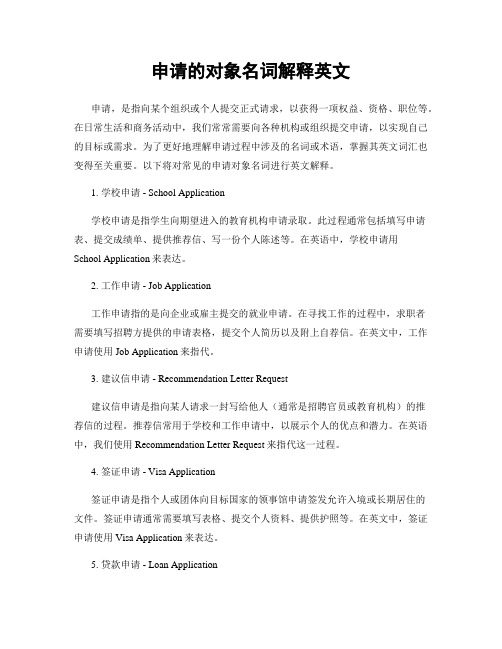
申请的对象名词解释英文申请,是指向某个组织或个人提交正式请求,以获得一项权益、资格、职位等。
在日常生活和商务活动中,我们常常需要向各种机构或组织提交申请,以实现自己的目标或需求。
为了更好地理解申请过程中涉及的名词或术语,掌握其英文词汇也变得至关重要。
以下将对常见的申请对象名词进行英文解释。
1. 学校申请 - School Application学校申请是指学生向期望进入的教育机构申请录取。
此过程通常包括填写申请表、提交成绩单、提供推荐信、写一份个人陈述等。
在英语中,学校申请用School Application来表达。
2. 工作申请 - Job Application工作申请指的是向企业或雇主提交的就业申请。
在寻找工作的过程中,求职者需要填写招聘方提供的申请表格,提交个人简历以及附上自荐信。
在英文中,工作申请使用Job Application来指代。
3. 建议信申请 - Recommendation Letter Request建议信申请是指向某人请求一封写给他人(通常是招聘官员或教育机构)的推荐信的过程。
推荐信常用于学校和工作申请中,以展示个人的优点和潜力。
在英语中,我们使用Recommendation Letter Request来指代这一过程。
4. 签证申请 - Visa Application签证申请是指个人或团体向目标国家的领事馆申请签发允许入境或长期居住的文件。
签证申请通常需要填写表格、提交个人资料、提供护照等。
在英文中,签证申请使用Visa Application来表达。
5. 贷款申请 - Loan Application贷款申请,是指向银行或其他金融机构提交的贷款请求。
这种申请通常需要填写表格,提供有关财务状况和借款用途的文件。
在英语中,贷款申请使用Loan Application来表示。
6. 保险申请 - Insurance Application保险申请是指向保险公司提交的购买保险的请求。
调查表(中英文)
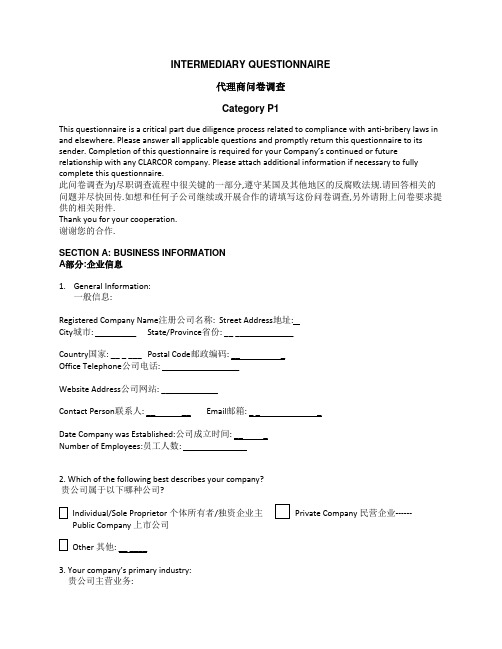
INTERMEDIARY QUESTIONNAIRE代理商问卷调查Category P1This questionnaire is a critical part due diligence process related to complia nce with anti‐bribery laws in and elsewhere. Please answer all applicable questions and promptly return this questionnaire to its sender. Completion of this questionnaire is required for your Company’s continued or future relationship with any CLARCOR company. Please attach additional information if necessary to fully complete this questionnaire.此问卷调查为)尽职调查流程中很关键的一部分,遵守某国及其他地区的反腐败法规.请回答相关的问题并尽快回传.如想和任何子公司继续或开展合作的请填写这份问卷调查,另外请附上问卷要求提供的相关附件.Thank you for your cooperation.谢谢您的合作.SECTION A: BUSINESS INFORMATIONA部分:企业信息1.General Information:一般信息:Registered Company Name注册公司名称: Street Address地址: _City城市: __ ___ State/Province省份: __ _ __Country国家: __ _ ___ Postal Code邮政编码: __ _Office Telephone公司电话: __ __Website Address公司网站: __ __Contact Person联系人: __ __ Email邮箱: _ _ _Date Company was Established:公司成立时间: __ _Number of Employees:员工人数: ___ __2. Which of the following best describes your company?贵公司属于以下哪种公司?Individual/Sole Proprietor 个体所有者/独资企业主Private Company 民营企业------Public Company 上市公司Other 其他: __ ____3. Your company’s primary industry:贵公司主营业务:Construction 建筑Engineering工程Defense/Aerospace国防/航空Filtration 过滤Manufacturing制造Oil / Gas / Energy石油/天然气/能源Transportation 交通运输Other其他: ____________________________________4. Your company’s current or pending relationship with a CLARCOR company:贵公司现在或者将来与我公司的关系:Consultant咨询顾问Distributor代理商sales Agent销售代表Supplier供应商Other其他: ____________________________________5. Will your company engage any other third party (e.g., consultant, sales agent, etc.) to assist in your company’s business relationship with the CLARCOR company?贵公司会雇佣任何第三方机构 (例如:咨询顾问公司,销售代理等) 来帮助销售产品吗?No 否 Yes 是If yes, describe their involvement:如选是,请描述他们是怎么参与的 : -----------------------------------------------------------------6. Identify the countries where your company does business:请指出贵公司在那些国家从事业务: _______国外没有业绩,目前仅限于国内____.7. Does your company have any subsidiary organizations?贵公司有子公司吗?No 否 Yes 是(If yes, complete the following for each subsidiary)(如有,请完善以下子公司信息 )Name公司名称:_______________________________________________________________________________ Address地址:_____________________________________________________________________________City城市:_________________________________________________________________________________ State/Province省:________________________________________________________________________Country国家:_____________________________________________________________________________ Postal Code邮政编码:__________________________________________________________________________Office Telephone公司电话:______________________________________________________________________8. Is your company part of any joint ventures?贵公司有合资成分吗?No 否 Yes 是(If yes, complete the following)(如是,请按如下填写)Name of Joint Venture合资企业名称:__________________________________________________________________Address地址:_____________________________________________________________________________ City城市:_________________________________________________________________________________ State/Province省:________________________________________________________________________Country国家:_____________________________________________________________________________ Postal Code邮政编码:__________________________________________________________________________Office Telephone公司电话:______________________________________________________________________Primary Industry of Joint Venture合资企业主营业务:_________________________________________________________9. Please provide background information on your company’s expertise and business activities. Include a brochure or recent annual report, if available.(填写业务范围即可)请提供公司专营业务活动的资质和背景资料,可以的话请提供样本资料或最近的年度报告._____________________________________________________________________________________ _____________________________________________________________________________________ _____________________________________________________________________________________SECTION B: REFERENCE INFORMATIONB部分:参考信息1. Provide two external business references with whom CLARCOR may inquire if it chooses.请提供两个贵公司业务上往来的公司,日后查询.(填写不重复的供应商信息)2. Will your company provide a recent audited financial statement?贵公司愿意提供最近的经审计的财务报表吗?No 否 Yes 是如果没有,请提供一份可供公司以后查询贵公司财务状况稳定性的财务参考资料,例如银行,供应商信息等. (请提供除了B部分问题1中第三个供应商的资料)SECTION C: INFORMATION ABOUT “KEY PEOPLE”C部分:”主要负责人”信息1.List all owners, partners or shareholders of your company (percentage should total 100%). Includeany government ownership. You may skip this question if your company is publicly held. However, if your company is publicly held and you know that some of its shares are owned or controlled by a government or government entity, please identify the government or government entity.请列出贵公司的所有人, 合伙人或者股东 (按总为 100%股份比例). 包括任何国有成分.如果您公司是上市公司可以跳过这个问题. 但是,如果您知道公司有部分股份是国有的或者是政府单位所有的,请指出.(只需填写持股人信息)2.List the individuals on your company’s Board of Directors.请列出公司董事会的成员.3. List all company managers who will interact with the company or assist in the sale of its products:Please provide a resume or short biographical background for all of the “Key People” listed above in this Section C (i.e., all non‐entity owners, partners or shareholders, members of the Bo ard of Directors and all company employees who will interact with the company or assist in the sale of its products).请提供C 部分上出现的”主要负责人”的一份简短简历(例如:所有企业主,合伙人或者股东,董事会成员和所有负责销售Clarcor 产品的公司员工)4. Have any of the Key People listed above held a job in the last 5 years with the government, anygovernment agency (including the military) or any government owned or government controlled entity? 在过去的五年里,上面列出的”主要负责人”有否在政府,政府机关(包括军队)或者任何国有企业或国有控股企业工作过吗?No 否 Yes 是(If yes, please complete the information below) (如果有,请填写下面的信息)5. Do any of the Key People provide any services to or have or seek any business with a government, any government agency (including the military) or any government owned or government controlled entity? 这些”主要负责人”是否曾经或正在从事与任何政府,政府机关(包括军队),国有企业或者国有控股企业的商务往来?No 否 Yes (Complete chart below)是(请填写下面表格)6. Do any of the Key People currently hold any position with or have any substantial duties for anypolitical party or political campaign?“主要负责人”有否在任何政党里任职或担任重要职位?No 否Yes(Complete chart below)是(请完成下面表格)7. Are any of the Key People a candidate for any political office?“主要负责人”里面有是政党候选人吗?No 否Yes (Complete chart below)是(请完成下面表格)8. Are any close relatives of any of the Key People:“主要负责人”的亲属里面有没有:a)Employed or otherwise engaged in any capacity by a government, any government agency(includingthe military) or any government owned or government controlled entity?在任何政府,政府机关(包括军队)或者国有企业和国有控股企业里面任职或从事工作?No 否Yes是b) Hold any position with or have substantial duties for any political party or political campaign?在任何政党里任职或担任重要职位?No 否Yes是c) A candidate for any political office?是政党候选人?No 否 Yes是(If “yes” to one or more of these questions, please complete the information below)9. Will your company soli cit or assist in the sale of the company’s products to a government, any government agency (including the military) or any government owned or government controlled entity? 您公司会帮助销售公司的产品给政府,任何政府机关(包括军队),或者国有企业和国有控股企业吗?No 否Yes是(If yes, identify each potential purchaser)(如果回答”是”,请把潜在的购买方详细指出)_____________________________________________________________________________________ _____________________________________________________________________________________ _____________________________________________________________________________________ SECTION D: COMPLIANCE INFORMATIOND部分:合规信息1.Does your company currently have a written policy addressing bribery?您公司现在有返贿赂的明文规定吗?No 否 Yes (please provide a copy)是(请提供一份附件)2. Please respond to the following questions on behalf of your company and all Key People listed in Section C. Please provide an explanation if the answer to any question is “yes.”请代表贵公司及所有C部分列出的”主要负责人”回应下面的问题.请对答案为”是”的答案进行解释说明.a) Has your company or any of the Key People ever been charged or convicted as part of anyinvestigation or litigation involving (i) bribery, fraud or corruption, (ii) securities orcommodities trading laws, or (iii)anti‐trust or anti‐competition laws?您公司或任何”主要负责人”曾经被调查或起诉涉嫌(i)贿赂,商业诈骗或者腐败(ii)违反证券或商品贸易法律(iii)违反反垄断和竞争法No 否 Yes 是b) Has your company or any of the Key People ever been ever been debarred from competingfor government contracts in any country?No 否 Yes 是______________________________________[Name of Company]公司名称By: ___________________________________[Signature]签字Name:_____________ [Print Name]姓名Title:_____ _____职务Date:_____ ___ 日期。
封装专用英语词汇
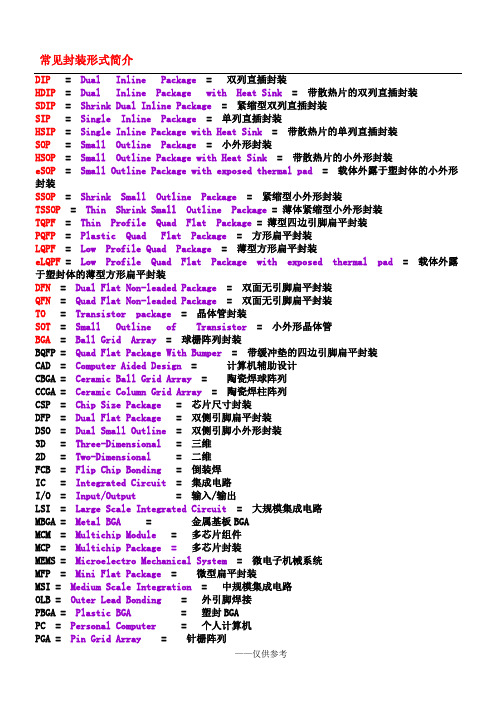
常见封装形式简介DIP = Dual Inline Package = 双列直插封装HDIP = Dual Inline Package with Heat Sink = 带散热片的双列直插封装SDIP = Shrink Dual Inline Package = 紧缩型双列直插封装SIP = Single Inline Package = 单列直插封装HSIP = Single Inline Package with Heat Sink = 带散热片的单列直插封装SOP = Small Outline Package = 小外形封装HSOP = Small Outline Package with Heat Sink = 带散热片的小外形封装eSOP = Small Outline Package with exposed thermal pad = 载体外露于塑封体的小外形封装SSOPTSSOPTQPFPQFPLQPFeLQPFDFN =QFN =TO =SOT =BGA =BQFP =CAD =CBGA =CCGA =CSP =DFP =DSO =3D =2D =FCB =IC =I/O =LSI =MBGA = Metal BGA = 金属基板BGAMCM = Multichip Module = 多芯片组件MCP = Multichip Package =多芯片封装MEMS = Microelectro Mechanical System = 微电子机械系统MFP = Mini Flat Package = 微型扁平封装MSI = Medium Scale Integration = 中规模集成电路OLB = Outer Lead Bonding = 外引脚焊接PBGA = Plastic BGA = 塑封BGAPC = Personal Computer = 个人计算机PGA = Pin Grid Array = 针栅阵列SIP = System In a Package = 系统级封装SOIC = Small Outline Integrated Circuit = 小外形封装集成电路SOJ = Small Outline J-Lead Package = 小外形J形引脚封装SOP = Small Outline Package = 小外形封装SOP = System On a Package = 系统级封装WB = Wire Bonding = 引线健合WLP = Wafer Level Package = 晶圆片级封装常用文件、表单、报表中英文名称清除通知单Purge notice工程变更申请 ECR(Engineering Change Request)戴尔专案收据数据表核对表文件清单设备清单报名表日报表周报表月报表年报表年度报表财务报表品质报表生产报表符合性报告(材质一致性证明) COC(Certificate of Compliance) 稽核报告 Audit report品质稽核报告 Quality audit report制程稽核报告Process audit report5S 稽核报告 5S audit report客户稽核报告Customer audit report供应商稽核报告Supplier audit report年度稽核报告 Annual audit report内部稽核报告 Internal audit report外部稽核报告External audit reportSPC 报表(统计制程管制) Statistical process control工序能力指数(Cpk) Process capability index(规格)上限Upper limit(规格)下限 Lower limit规格上限Upper Specification Limit(USL) 规格下限 Lower Specification Limit(LSL)上控制限(或管制上限) Upper Control Limit(UCL)下控制限(或管制下限)Lower Control Limit(LCL)最大值 Maximum value平均值Average value最小值Minimum value临界值MRB 单(TECN压焊图订购单送货单/询价单返工单减薄:Grind??[ɡraind ]?vt. & vi. 磨碎;嚼碎n .磨,碾Crack???[kr?k]?? vt. & vi.? (使…)开裂, 破裂n.?裂缝, 缝隙Ink?[i?k] ?n. ?墨水, 油墨Die [dai]? vt. & vi. ?死亡(芯片)Dot?[d?t] ?n .?点, 小圆点Mounting?[‘maunti?] ?n.? 装备,衬托纸Tape?[teip] ?n.? 带子;录音磁带; 录像带Size?[saiz] ?n. ?大小, 尺寸,尺码Thick?[θik]? adj. 厚的,厚重的Thickness?[‘θiknis]?? n.? 厚(度), 深(度)宽 (度) Position?[p?‘zi??n]? n. ?方位,位置Rough?[r?f] ?adj .?粗糙的; 不平的Fine?[fain]? adj. ?美好的, 优秀的, 优良的, 杰出的Speed [spi:d]? n.? 速度, 速率Spark[spɑ:k]?n.? 火花; 火星Out?[aut]? adv. 离开某地, 不在里面;(火或灯)熄灭Grindstone???[‘ɡraindst?un]? n. ?磨石、砂轮MounterCard?[k划片:Street? n. ?大街, 街道Blade?[bleid] ?n. ?刀口, 刀刃,刀片Cut?[k?t]?vt. & vi. ?切, 剪, 割, 削Speed[spi:d]n.? 速度, 速率Spindle?[‘spindl]? n.? 主轴, (机器的)轴Size?[saiz]? n. ?大小, 尺寸?,尺码Cooling?['ku:li?]adj.? 冷却(的)Kerf?[k?:f] ?n.? 锯痕,截口,切口Width?[widθ] ?n . ?宽度, 阔度, 广度Chip?[t?ip] ?n. ?碎片、缺口Chipping[‘t?ipi?]n. ?碎屑,破片Crack[kr?k]vt . (使…)开裂,破裂n . 裂缝, 缝隙Missing?[‘misi?] adj. 失掉的,失踪的,找不到的Die [dai]? vt. & vi.? 死亡(芯片)Saw?[s?:]? n. ?锯vt. & vi. ?锯,往复运动Street ?[stri:t]n.? 大街, 街道Film?[film]? ?n.? 影片, 电影(薄膜,蓝膜)mount---刀片tape------上料---空气pressure---校准ink------限制cover---切割water---wheel---检查feed---new---新清洗? center上芯:Bonder?[‘b?nd?]? n. 联接器,接合器,粘合器Die attach material epoxy粘片胶Epoxy??[e‘p?ksi]?? n. 环氧树脂(导电胶)Material??[m?‘ti?ri?l]?? n.? 材料, 原料Non-conductive epoxy绝缘胶Conductive??[k?n‘d?ktiv]?? adj. 传导的Dispenser??[dis‘pens?] ?n. ?配药师, 药剂师Nozzle?[‘n?zl] ?n. ?管嘴, 喷嘴Rubber??[‘r?b?]? n. ?(合成)橡胶,橡皮Tip?[tip]?n. ?尖端, 末端Die pick-up tool 吸嘴Tool?[tu:l]? ?n.? 工具, 用具Collect?[k?‘lekt]? vt. ?收集, 采集(吸嘴)Ejector?[i‘d?ekt?]? n. ?驱逐者,放出器,排出器Pin?[pin] ?n. 针,大头针, 别针Lead Frame引线框架Lead??[li:d]? vt. & vi. ?带路, 领路, 指引Pick Level 捡拾芯片高度Head pick delay 粘接头拾取延迟Head bond delay 粘接头粘接延时Pick delay捡拾芯片延时Bond delay 粘接芯片延时Index?[‘indeks] ?n. ?索引;标志, 象征; 量度Clamp?[kl?mp]? vt. & vi. ?夹紧; 夹住n.?夹具Index clamp delay 步进夹转换延时Index delay 框架步进延时Shear??[?i?]?? vt.? 剪羊毛, 剪n.?大剪刀Test?[test]? n. ?测验,化验,试验, 检验Die shear test 推晶试验Thickness?['θiknis] ?n.? 厚(度), 粗Coverage?[‘k?v?rid?] ?n. ?覆盖范围Epoxy thickness & coverage 导电胶厚度和覆盖率Orientation[,?:rien‘tei??n]? n.? 方向, 目标Die Orientation 芯片方向Epoxy curing银浆烘烤Edge?[ed?]?n.?? 边, 棱, 边缘Partial?[‘pɑ:??l] ?adj.? 部分的, 不完全的Mirror?[‘mir?]?? ?n. ? 镜子Missing?[‘misi?] adj.? 失掉的,失踪的,找不到的Edge die / partial die边缘片 / 边沿芯片Mirror die光片 / 镜子芯片Missing die 掉芯 / 漏芯 / 掉片Splash [spl??]vt. 使(液体)溅起vi.(液体)溅落Splatter ?[‘spl?t?]vt. & vi.? (使某物)溅泼Diagram [‘dai?ɡr?m] ?n. ?图解, 简图, 图表Ink splash / ink splatter墨溅Die bonding diagram 上芯图Die shesr test 推片实验/推晶试验Die shear tester 推片试验机Die shesr tool 推片头Metal corrosion晶粒腐蚀/芯片腐蚀wafer------银胶---参数manual---错误input------压力vacuum---针---改机---调整contact---崩边pause------校准cassette---铁圈nozzle---点胶头 writer---划胶头压焊:Wire?[‘wai?]?n.?金属丝, 金属线;电线, 导线Bond?[b?nd]? n.?接合, 结合vt.?使粘结, 使结合Wire bond / Wiring bonding 压焊/焊丝/球焊Gold wire金丝Pad? [p?d]? vt.?给…装衬垫, 加垫子n.垫,护垫Bond pad 焊点、铝垫1st bond第一焊点Pad size焊点尺寸 / 铝垫尺寸Capillary?[k?‘pil?ri]?n.毛细管;毛细血管(劈刀)Pitch??[pit?]?? 程度; 强度; 高度Pad pitch铝垫间距 / 焊点间距EFO打火烧球loop?[lu:p]? n.? 圈, 环, 环状物Loop height 孤高Wire pull test 拉力试验Ball shear test 金球推力试验PIN 1 第一脚Ball height 球高Ball diameter球径Cratering??[‘kreit?ri?]?n. ?缩孔;陷穴(弹坑)KOH etching test KOH腐蚀试验Bond Cratering test 压焊腐蚀试验(弹坑试验) Thermal?[‘θ?:m?l]?adj. 热的,热量的Compression?[k?m‘pre??n]?n.?挤压, 压缩TCB( Thermal Compression Bond)热压焊N2 BOXRTPCFBIMetal?[‘metl]?n.?金属Discolor?[dis‘k?l?] ?v.使脱色;(使)变色,(使)褪色Oxide?[‘?ksaid]n.?氧化物Metal Discolor铝条变色Bond Pad Discolor 铝垫变色Bond Pad Oxide铝垫氧化Stick?[stik] ?vt. & vi.?粘贴, 张贴Peeling?[‘pi:li?] n. 剥皮,剥下的皮Crateri ng??[‘kreit?ri?]n. ?缩孔;陷穴(弹坑)Nonstick bond on pad 铝垫不粘Bond pad peeling 铝垫脱落Bond pad cratering铝垫弹坑Limit?[‘limit] ?vt.?限制; 限定Scratch?[skr?t?]?vt. & vi.?抓, 搔,?刮伤High loop弧度太高Loop short 弧度短路Overhang?[,?uv?‘h??]vt. 伸出; 悬挂于…之上Residue?[‘rezidju:]?n. 剩余, 余渣Distortion?[dis‘t?:??n] ?n. 歪曲,曲解Wire overhang on LD 跨越引线框架Wire residue 残丝LF distortion 引线框架变形Quantity?[‘kw?ntiti] ?n.?数目, 数量Mismatch?[‘mis’m?t?] ?vt. 使配错,使配合不当Scrap?[skr?p] ?n.?废料vt.?废弃, 丢弃Scratch?[skr?t?] vt. 刮伤Quantity Mismatch 数量不符Empty M. not scrap空粘未报废Teach---BQM---Bond offweld off---管脚脱焊 crater---裂缝 gold wire---金线 missing ball---球未烧好 weak bond---虚焊塑封:Mold?[m?uld]? n.?模子,铸型vt.?浇铸,塑造Molding?[‘m?uldi?]?n.?成型(塑封)Compound?[‘k?mpaund]?n.?复合物, 化合物Moiding M/C;Mold Press塑封机Press?[pres]? n.?印刷机Heater?[‘hi:t?]?n.?加热器; 炉子Pre-heater 预热机Chase?[t?eis]? n.?追捕, 追猎Mold die / Mold chase 塑封模具MGP mold MGP多缸模具temperTransfer speed注塑速度Transfer time注塑时间PMC time (Post Mold Cure Time)后固化时间Load / unload上料/下料Sweep ?[swi:p]?vt. & vi.?扫, 打扫, 拂去Wire Sweep 冲丝Open 开路Short 短路Fill ?[fil] vt. & vi. ?(使)充满, (使)装满, 填满Underfill?['?nd?fil]?n.?(孔型)未充满Body underfilled胶体未灌满Incomplete [,?nk?m‘pli:t] adj. 不完全的, 未完成的Incomplete mold 未封满Chip ?[t?ip]? n.?碎片,缺口BTM width / length 背面宽 / 长Top width / length 正面宽 / 长PKG thick 塑封体厚度Mismatch [‘mis’m?t?] vt.?使配错,使配合不当Mold mismatch / PKG mismatch 包封偏差(胶体错位)Offset [‘?fset] vt.?抵消, 补偿Misalignment [‘mis?lainm?nt]?n.?未对准Mold offset / PKG misalignment偏心PMC(post mold cure)后固化Dummy [‘d?mi]?n.??人体模型Strip [strip]? vt.?剥去,?剥夺, 夺走Dummy molded strip空封Mold flash 废胶Gate [ɡeit]? n.?门, 栅栏门AgingGun [ɡ?n]?? n.??枪, 炮Coating [‘k?uti?]?n.??涂层, 覆盖层Material ?[m?‘ti?ri?l]? n.?材料, 原料,素材, 资料Air Gun气枪Die Coating芯片涂胶Auto die coating M/C 芯片涂胶机Die Coating Material覆晶胶Cart [kɑ:t] ?n.?手推车ASS’YB Cart 后站推车Tablet [‘t?blit]? n. ?药片、胶囊Loader [‘l?ud?] ? n.? 装货的人,装货设备,装弹机Preheater [‘pri:’hi:t?] ? n. 预热器Fixture [‘fikst??] n. (房屋等的)固定装置Auto Tablet Loader 自动排胶粒机OffloadTransferMotor---CylinderPickerPin---针Cable–导线 Profile---温度曲线 Alarm---报警Error---错误 Driver---驱动 Sensor–感应器Inspection---检查Parameter---参数 Manual---手动,手册Reset---复位 Initialing---初始化 Guide–导轨Substrate---基板 Device---产品种类 Lot Traveller---随工单Magazine---盒子 Cylinder –汽缸 Bearing–轴承Stop---停止Emergency Stop---紧急停止 Gripper --夹子Heat–加热器Pipe–管子Temperature---温度Hopper–漏斗Compress air–压缩空气Over flow—反面漏胶Semiconductor---半导体 Molding –模封Operation–操作Flange–法兰盘 Pump–泵Chamber–腔体Vent–气孔Value–值Alarm---报警Error---错误 Inspection---检查 Parameter---参数 Manual---手动,手册Reset---复位Initialing---初始化Incomplete fill模封不全inchingmismatch---毛刺切筋1 切筋2 切筋模3 成形模4 分离模5 冲废6 检测7 再成型机模具Reform Die8 再成型机 Reform system9 料盘 Plastic tray10 连筋 Uncut dambar11 毛刺burr14 溢料Junk15 裂纹Crack16 离层(分层) Delaminating17 管脚反翘 Lead tip bend18 筋未切 Dam-bar uncut19 筋凸出 Dam-bar protrusion20 筋切入Dam-bar cut in打印 Marking1 打印Marking2 印章345 正印6 背印7 镜头89 漏打10 断字11 缺字121314 重印151619 电流21 字体(字形) Font22 定位针 Location pin23 胶皮打印机 Pad printer24 激光打印机 Laser Marking M/C25 后固化 PMC(Post Mold Cure)26 后固化烤箱 PMC Oven27 打印污斑 Marking stain28 印记移位Marking shift电镀 Plating1 电镀 Plating2 来料Incoming3 冲废 Dejunk4 热煮软化槽 Socking Tank7 检验 Inspection 外观检测8 烘烤9 出料101112 搭锡131415 发黄16 发黑17 变色1819 粘污202122 外观2324 无铅化 Pb-free / lead free25 结合力 Adhesive force26 可靠性Reliability27 电解Electrolytic deflash28 清洗(自来水)City water29 高压清洗 High pressure rinse30 脱脂 Descale31 清洗(纯水) DI water32 活化(合金) Activation33 预镀、预浸 Pre-dip34 电镀Plating35 吹风 Air blow36 中和Neutralization37 褪镀Stripper38 拖出394041 纯锡42 纯水(43 水压44454647 C5152 预浸53545556 中和59 烘干60 锡球 Solder ball61 锡厚度和成分 Sn thickness & composition62 冲废De-junk去胶渣63 去溢料 Degate 冲塑,冲胶64 去飞边 Deflash 去胶(塑封工序)65 锡铅电镀 Tin lead plating66 无铅电镀 Lead free plating; Pure tin plating67 镀层起泡Solder bump68 镀层剥落 Solder peel off69 镀层偏厚或偏薄 Thick or Thin Plating70 退锡 Solder remove71 电镀报废Plating scrap72 锡渣 Solder peeling73 电镀锡块Solder bump74757677测试1 测试2 打印34 编带568 划伤9 打错101112 模糊 Fade mark13 脚长Lead length14 脚宽 Lead width15 站立度 Stand up16 脚间距 Lead pitch17 共面性 Coplanarity18 跨度 Row space19 电性能测试 Electrical test20 塑料管 Plastic tube21 编带 Reel / Tape22 托盘,盘装 Tray23 扫描测脚 Leads Scan/Inspection24 扫描测脚机Leads scanner25 投影仪 Profile Projector测试LaserLampTrackBeamSensor 传感器Motor 马达Driver 驱动器Index 步进Tool 模具Press 模具Punch 刀具Jam 卡料Forming 成型Cylinder气缸Laser head 光头Magazine 盒子Tube 管子Tray 板子ArmLampAlarmErrorRetestSampleResample 重新抽样Black box盛放未测试产品的黑盒子Testing area 测试区域Test chuck 测试平台Device Interface Board(DIB) 芯片测试接口板DUT 正在测试芯片A/D (analog-to-digital) converter 模/数转换模块EOT 测试结束信号SOT测试开始信号BIN signal 分BIN 信号Socket 测试座JIG/Test Head 测试盒/测试头Interface Card 接口通讯卡Interface Cable 接口通讯线CheckerFingerCapacitor box 电容盒。
宝洁面试经典八大问题(附答案范例)

宝洁面试经典八大问题(附答案范例)宝洁公司在中国高校招聘采用的面试评价测试方法主要是经历背景面谈法,即根据一些既定考察方面和问题来收集应聘者所提供的事例,从而来考核该应聘者的综合素质和能力。
宝洁的面试由8个核心问题组成。
宝洁公司招聘题号称由高级人力资源专家设计,无论您如实或编造回答, 都能反应您某一方面的能力。
核心部分的题如下:Please provide concise examples that will help us better understand your capabilities.(1)Describe an instance where you set your sights on a high/demanding goal and saw it through completion. (请你举一个具体的例子,说明你给自己确定了一个很高的目标,然后达到这个目标。
)问题分析:这个问题的考察应聘者制定高目标的勇气及完成高目标的执行力。
关键词为:demanding goal、saw it through。
回答范例:(记住,采用“What+STAR+Key Words法则”来回答)What:Designed a show to celebrate the Anniversary of Xiamen University, and won 2nd Prize out of 12 teams.Situation(Key Word:demanding)On the anniversary night, there was a huge celebration party, where songs, dances and dramas were played. Each school should design five shows, and our class volunteered to design one. It was a demanding goal as it was very close to the end of the term when most students were busy preparing for final exams.Task:As a sophomore student I was in charge of my class performance, which was a drama. I had to deal with the pressure from study, my classmates’ disinterest in acting, and my role as the king in the drama.Actions:(Key Words:how I saw it through)First, as there were only 20 students in my class, I distributed at least one task to each student; either a role, or making tools or costumes.Second, since at the end of the term each member was busy with study, the rehearsal schedule should be reasonable and periodic. All team members cooperated well because of the low frequency and short duration of each rehearsal.Third, music and scenery were added into rehearsal in order to get close to the circumstances of the party.In addition, I emphasized the value of time and ordered every actor to respect other partners.Result:In the end, our performance was very successful. Not only did I act the “king” wonderfully, but also got good marks on the final exam.(2)Summarize a situation where you took the initiative to get others on an important task or issue, and played a leading role to achieve the results you wanted. (请举例说明你在一项团队活动中如何团结他人,并且起到领导者的作用,并带领团队最终获得所希望的结果。
宝洁实习生展示宝洁【英文】

The Importance of Western Europe
About 25 % of P&G sales
Geneva Business Centre (GBC) – Geneva, Switzerland
a new challenge everyday
8
And now why an internship at P&G?
a new challenge everyday
15
What are the internship opportunities at P&G?
a new challenge everyday
Structure
Finance
Not a Data cruncher but a “well rounded” Business leader
everyday P&G products • Spend nearly $ 2by billion a year on R&D
•Spends more than $5 million a day on R&D
a new challenge everyday
6
a new challenge everyday
a new challenge everyday
Your internship in 3 Steps!
Some More details
Apply online before November 12th
Please mention “HEC Lausanne 2007” in your application Put as title of your CV “HEC Lausanne 2007” Complete online questionnaire This takes time, but it is a pre-requisite!
调查表(中英文)

INTERMEDIARY QUESTIONNAIRE代理商问卷调查Category P1This questionnaire is a critical part due diligence process related to complia nce with anti‐bribery laws in and elsewhere. Please answer all applicable questions and promptly return this questionnaire to its sender. Completion of this questionnaire is required for your Company’s continued or future relationship with any CLARCOR company. Please attach additional information if necessary to fully complete this questionnaire.此问卷调查为)尽职调查流程中很关键的一部分,遵守某国及其他地区的反腐败法规.请回答相关的问题并尽快回传.如想和任何子公司继续或开展合作的请填写这份问卷调查,另外请附上问卷要求提供的相关附件.Thank you for your cooperation.谢谢您的合作.SECTION A: BUSINESS INFORMATIONA部分:企业信息1.General Information:一般信息:Registered Company Name注册公司名称: Street Address地址: _City城市: __ ___ State/Province省份: __ _ __Country国家: __ _ ___ Postal Code邮政编码: __ _Office Telephone公司电话: __ __Website Address公司网站: __ __Contact Person联系人: __ __ Email邮箱: _ _ _Date Company was Established:公司成立时间: __ _Number of Employees:员工人数: ___ __2. Which of the following best describes your company?贵公司属于以下哪种公司?Individual/Sole Proprietor 个体所有者/独资企业主Private Company 民营企业------Public Company 上市公司Other 其他: __ ____3. Your company’s primary industry:贵公司主营业务:Construction 建筑Engineering工程Defense/Aerospace国防/航空Filtration 过滤Manufacturing制造Oil / Gas / Energy石油/天然气/能源Transportation 交通运输Other其他: ____________________________________4. Your company’s current or pending relationship with a CLARCOR company:贵公司现在或者将来与我公司的关系:Consultant咨询顾问Distributor代理商sales Agent销售代表Supplier供应商Other其他: ____________________________________5. Will your company engage any other third party (e.g., consultant, sales agent, etc.) to assist in your company’s business relationship with the CLARCOR company?贵公司会雇佣任何第三方机构 (例如:咨询顾问公司,销售代理等) 来帮助销售产品吗?No 否 Yes 是If yes, describe their involvement:如选是,请描述他们是怎么参与的 : -----------------------------------------------------------------6. Identify the countries where your company does business:请指出贵公司在那些国家从事业务: _______国外没有业绩,目前仅限于国内____.7. Does your company have any subsidiary organizations?贵公司有子公司吗?No 否 Yes 是(If yes, complete the following for each subsidiary)(如有,请完善以下子公司信息 )Name公司名称:_______________________________________________________________________________ Address地址:_____________________________________________________________________________City城市:_________________________________________________________________________________ State/Province省:________________________________________________________________________Country国家:_____________________________________________________________________________ Postal Code邮政编码:__________________________________________________________________________Office Telephone公司电话:______________________________________________________________________8. Is your company part of any joint ventures?贵公司有合资成分吗?No 否 Yes 是(If yes, complete the following)(如是,请按如下填写)Name of Joint Venture合资企业名称:__________________________________________________________________Address地址:_____________________________________________________________________________ City城市:_________________________________________________________________________________ State/Province省:________________________________________________________________________Country国家:_____________________________________________________________________________ Postal Code邮政编码:__________________________________________________________________________Office Telephone公司电话:______________________________________________________________________Primary Industry of Joint Venture合资企业主营业务:_________________________________________________________9. Please provide background information on your company’s expertise and business activities. Include a brochure or recent annual report, if available.(填写业务范围即可)请提供公司专营业务活动的资质和背景资料,可以的话请提供样本资料或最近的年度报告._____________________________________________________________________________________ _____________________________________________________________________________________ _____________________________________________________________________________________SECTION B: REFERENCE INFORMATIONB部分:参考信息1. Provide two external business references with whom CLARCOR may inquire if it chooses.请提供两个贵公司业务上往来的公司,日后查询.(填写不重复的供应商信息)2. Will your company provide a recent audited financial statement?贵公司愿意提供最近的经审计的财务报表吗?No 否 Yes 是如果没有,请提供一份可供公司以后查询贵公司财务状况稳定性的财务参考资料,例如银行,供应商信息等. (请提供除了B部分问题1中第三个供应商的资料)SECTION C: INFORMATION ABOUT “KEY PEOPLE”C部分:”主要负责人”信息1.List all owners, partners or shareholders of your company (percentage should total 100%). Includeany government ownership. You may skip this question if your company is publicly held. However, if your company is publicly held and you know that some of its shares are owned or controlled by a government or government entity, please identify the government or government entity.请列出贵公司的所有人, 合伙人或者股东 (按总为 100%股份比例). 包括任何国有成分.如果您公司是上市公司可以跳过这个问题. 但是,如果您知道公司有部分股份是国有的或者是政府单位所有的,请指出.(只需填写持股人信息)2.List the individuals on your company’s Board of Directors.请列出公司董事会的成员.3. List all company managers who will interact with the company or assist in the sale of its products:Please provide a resume or short biographical background for all of the “Key People” listed above in this Section C (i.e., all non‐entity owners, partners or shareholders, members of the Bo ard of Directors and all company employees who will interact with the company or assist in the sale of its products).请提供C 部分上出现的”主要负责人”的一份简短简历(例如:所有企业主,合伙人或者股东,董事会成员和所有负责销售Clarcor 产品的公司员工)4. Have any of the Key People listed above held a job in the last 5 years with the government, anygovernment agency (including the military) or any government owned or government controlled entity? 在过去的五年里,上面列出的”主要负责人”有否在政府,政府机关(包括军队)或者任何国有企业或国有控股企业工作过吗?No 否 Yes 是(If yes, please complete the information below) (如果有,请填写下面的信息)5. Do any of the Key People provide any services to or have or seek any business with a government, any government agency (including the military) or any government owned or government controlled entity? 这些”主要负责人”是否曾经或正在从事与任何政府,政府机关(包括军队),国有企业或者国有控股企业的商务往来?No 否 Yes (Complete chart below)是(请填写下面表格)6. Do any of the Key People currently hold any position with or have any substantial duties for anypolitical party or political campaign?“主要负责人”有否在任何政党里任职或担任重要职位?No 否Yes(Complete chart below)是(请完成下面表格)7. Are any of the Key People a candidate for any political office?“主要负责人”里面有是政党候选人吗?No 否Yes (Complete chart below)是(请完成下面表格)8. Are any close relatives of any of the Key People:“主要负责人”的亲属里面有没有:a)Employed or otherwise engaged in any capacity by a government, any government agency(includingthe military) or any government owned or government controlled entity?在任何政府,政府机关(包括军队)或者国有企业和国有控股企业里面任职或从事工作?No 否Yes是b) Hold any position with or have substantial duties for any political party or political campaign?在任何政党里任职或担任重要职位?No 否Yes是c) A candidate for any political office?是政党候选人?No 否 Yes是(If “yes” to one or more of these questions, please complete the information below)9. Will your company soli cit or assist in the sale of the company’s products to a government, any government agency (including the military) or any government owned or government controlled entity? 您公司会帮助销售公司的产品给政府,任何政府机关(包括军队),或者国有企业和国有控股企业吗?No 否Yes是(If yes, identify each potential purchaser)(如果回答”是”,请把潜在的购买方详细指出)_____________________________________________________________________________________ _____________________________________________________________________________________ _____________________________________________________________________________________ SECTION D: COMPLIANCE INFORMATIOND部分:合规信息1.Does your company currently have a written policy addressing bribery?您公司现在有返贿赂的明文规定吗?No 否 Yes (please provide a copy)是(请提供一份附件)2. Please respond to the following questions on behalf of your company and all Key People listed in Section C. Please provide an explanation if the answer to any question is “yes.”请代表贵公司及所有C部分列出的”主要负责人”回应下面的问题.请对答案为”是”的答案进行解释说明.a) Has your company or any of the Key People ever been charged or convicted as part of anyinvestigation or litigation involving (i) bribery, fraud or corruption, (ii) securities orcommodities trading laws, or (iii)anti‐trust or anti‐competition laws?您公司或任何”主要负责人”曾经被调查或起诉涉嫌(i)贿赂,商业诈骗或者腐败(ii)违反证券或商品贸易法律(iii)违反反垄断和竞争法No 否 Yes 是b) Has your company or any of the Key People ever been ever been debarred from competingfor government contracts in any country?No 否 Yes 是______________________________________[Name of Company]公司名称By: ___________________________________[Signature]签字Name:_____________ [Print Name]姓名Title:_____ _____职务Date:_____ ___ 日期。
市场营销专业术语中英文对照标准翻译
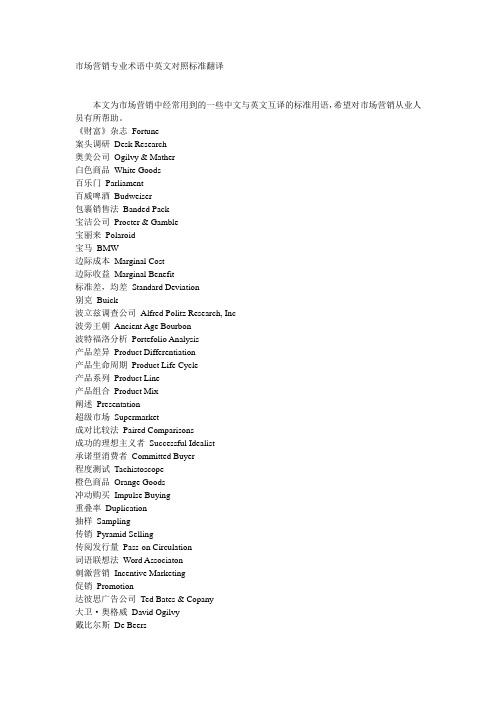
市场营销专业术语中英文对照标准翻译本文为市场营销中经常用到的一些中文与英文互译的标准用语,希望对市场营销从业人员有所帮助。
《财富》杂志Fortune案头调研Desk Research奥美公司Ogilvy & Mather白色商品White Goods百乐门Parliament百威啤酒Budweiser包裹销售法Banded Pack宝洁公司Procter & Gamble宝丽来Polaroid宝马BMW边际成本Marginal Cost边际收益Marginal Benefit标准差,均差Standard Deviation别克Buick波立兹调查公司Alfred Politz Research, Inc波旁王朝Ancient Age Bourbon波特福洛分析Portefolio Analysis产品差异Product Differentiation产品生命周期Product Life Cycle产品系列Product Line产品组合Product Mix阐述Presentation超级市场Supermarket成对比较法Paired Comparisons成功的理想主义者Successful Idealist承诺型消费者Committed Buyer程度测试Tachistoscope橙色商品Orange Goods冲动购买Impulse Buying重叠率Duplication抽样Sampling传销Pyramid Selling传阅发行量Pass-on Circulation词语联想法Word Associaton刺激营销Incentive Marketing促销Promotion达彼思广告公司Ted Bates & Copany大卫·奥格威David Ogilvy戴比尔斯De Beers丹尼尔·斯塔奇公司Danile Starch & Staff 弹性Elasticity到达率Reach道奇Dodge第三者法Third-Person Technique第一提及Top of Mind电话访问Telephone Interview电通广告公司Dentsu电子售点数据EPOS Data定量研究Quantitative Research定位Positioning定性研究Qualitative Research动机研究Motivation Research读者Readers读者人数Readership独特销售主张Unique Selling Proposition杜邦公司Du Pont多方面衡量Multi-dimensional Scaling多品牌战略Multi-brand Strategy惰性销售Inertia Selling恩格尔曲线Engel Curves二手资料Secondary Data发行量Circulation发行量稽核组织ABC仿造Me Too访问Interview访问员Interviewer非处方药OTC菲力普·莫里斯公司Philip Morris Company 菲亚特FIAT肥皂剧Soap Opera分刊测试Split-run Test分销Distribution丰田TOYATA缝隙分析Gap Analysis浮动插播Floating Spot辅助回想Aided Recall付费发行量Paid Circulation复核Back Checking复核Validation富豪汽车VOLVO富可视Infocus富士胶卷FUJI FILM覆盖率Coverage盖凡尼克皮肤反应测试仪Galvanic Skin Response Meter盖洛普暨罗宾逊调查公司Gallup & Robinson,Inc概念测试Concept Testing高度介入产品High Invovement Procuct革新消费者Innovators葛瑞广告Grey Advertising公众调查公司Audience Research,Inc贡献Contrubution购买周期Buying Cycle孤独守巢人Empty Nesers鼓动销售Hard Sell故事板/分镜头表Storyboard故事完成法Story Completion观察调研法Obseravtion Study广告Advertising广告/销售比率Advertising/Sales Ratio广告比重Advertising Weight广告标准Advertising Standard广告调查基金会(美国) Advertising Research Foundation广告概要Advertising Brief广告口号Slogan广告目标即广告效果评测Defining Advertising Goals for Measured Advertising Results 国际商用机器公司IBM过度杀伤Overkill过滤审查Screening哈佛商学院Harvard Business School红色商品Red Goods互补品Complements花旗集团Citigroup华尔街Wall Street黄金时段Prime Time辉瑞Pfizer混合调查Omnibus Research混和调研Omnibus Research基本读者Primary Reader稽核Audit吉芬商品Giffen Goods吉列Gillette集团购买Organizational Buying集中度Affinity集中市场细分Concentrated Segmentation计算机辅助的电话采访Computer Assisted Telephone Interviewing记忆测试Recall Test记忆性Memorability佳能Canan家乐福Carrefour家庭(户) House Hold家庭稽核Home Audit家庭生活周期Family Life Cycle甲壳虫Bettle价格分析Values Analysis价格敏感Price Sensitive价格歧视Price Discrimination价格战Price War间接调研Off-the-research建议价格Recommended Price箭牌口香糖Wrigley讲究派头的诉求Snob Appeal交叉销售Cross-selling交替需求Alternate Demand焦点小组(讨论) Focus group (Discussion)角色扮演Role Playing阶式渗透Cascading结构化访问Structured Interview金佰利Kimberly-Clark浸透策略Penetration Strategy精工SEIKO句子完成法Sentence Completion决策群Decision Making Unit决定性调研Conclusive Research卡通测试Cartoon Tests开放题Open-ended Question开机率Homes Using TV柯达Kodak壳牌Shell可变价格Variable Pricing可口可乐Coca-Cola可丽舒Kleenex可信度Believability克莱斯勒Chrysler克劳德·霍普金斯Claude Hopkins客观看法Outside View肯德基炸鸡Kentucky Fried Chicken口碑广告Word-of-mouth Advertising快流量消费品Fast-moving Consumer Goods 拉力Pulling Power拦截访问Intercept Interview乐观奔命者Optimistic Striver离差Deviation李奥·贝纳Leo Burnett李佛兄弟公司Lever Brothers力士Lux连带外部效应Network Externality联合调研/辛迪加Syndicated Research联合分析Conjoint Analysis联合利华公司Unilever联想Association Techniques练习性预演Dry Run两步收费Two-part Tariff量表Scale劣等商品Inferior Goods零售周期Wheel of Retailing零头定价法Odd-even Pricing漏斗深入法Funnel Approach露华浓Revlon乱数表Random-number Table罗塞·瑞夫斯Rosser Reevse罗夏测试Rorschach Test骆驼Camal马丁·迈耶Martin Mayer麦当劳McDonald’s麦肯爱里克森广告公司Mccann-Erickson麦氏威尔咖啡Maxwell House Coffee卖方市场Seller’s Market满意购买者Satisfied Buyer盲测Blind Test毛评点Gross Ratting points媒体分析Media Analysis每千人(户)成本Cost Per Thousand Figure每千人成本Cost Per Mille美孚Mobil美国报纸发行人协会American Newspaper Publisher’s Association 美国电报电话公司AT&T美国广播公司ABC美国广告代理商协会4A’sThe American Association of Advertising Agencies美国民意研究中心American Institute of Public Opinion美国营销协会American Marketing Association美国运通American Express描述性调研Descriptive Research民意测验Opinion Poll明尼苏达矿务及制造业公司3M模似Simulation姆姆巧克力M&M耐克Nike尼尔逊公司A. C. Nielsen尼尔逊全国电视指数Nielsen National Television Index 尼尔逊受众测定器Nielsen audiometer尼尔逊指数Nielsen Index欧宝OPEL欧洲民意测验和市场调研协会ESOMAR帕累托原理Pareto Principle派生需求Derived Demand攀比效应Bandwagon Effect判断性抽样Judgement Sampling旁氏Pond’s陪伴购物Accompanied Shopping配额Quota配额抽样Quota Sampling频率分布Frequency Distribution品牌Brang品牌测试Brang Test品牌估价Brang Valuation品牌管理Brang Management品牌偏好Brang Preference品牌认知Brang Awareness品牌形象Brang Image品牌性格Brang Personalities品牌忠诚度Brang Loyalty品牌转换成本Switching Cost品质认知度Perceived Quality七喜7UP期望值Expectations期望值Expected V alue其他指导人Other-directed Person企业标志Corporate Logo企业识别Corporate Identity前导性研究Pilot Study潜意识广告Subliminal Advertising强生公司Johnson & Johnson乔治·格里宾George Gribbin情感购买者Like Friend情感象征Emotional Symbol渠道冲突Channel Conflict全国性涵盖度Blanket人口统计学特征Demographics人员推销Personal Selling认识差距Cognitive Dissonance认知Awareness认知图表Perceptual Mapping日后记忆Day-after-recall入户访问Door-to-door Interview软性促销Soft Sell萨奇公司Saatchi & Saatchi三维营销3-D商店稽核Store Audit社会等级Social Grading社会接受度Social Acceptability社会营销Social Marketing深度访谈Depth Interview生存者Survivor生活方式Lifestyle声音比例SOV声音份额Share of V oice施乐Xerox时代华纳Time Warner时机感Sense of Timing时间档次Time Slot时序分析Time-Series analysis识阈效应Threshold Effect使用与态度Usage and Attitude市场策略的利润效果Profit Impact of Market Strategy 市场调研Market Research市场调研/营销调研Marketing Research市场细分Market Segmentation市场占有率Market Share视听众暴露度Impession收获战略Harvesting Strategy收入效应Income Effect收视(听)率Ratings收视率Television Rating售点POP售点POS斯塔奇数字Starch Figure斯坦利·里索Stanley Resor斯沃琪Swatch四点分析SWOT Analysis随机抽样Random Sampling索尼SONY态度Attitude探索性调研Exploratory汤橱浓汤Campbell’s Soup特许经营Franchise替代品Substitutes替代效应Substitution Effect天美时Timex听众调查Audience Research通用汽车General Motor同类相食Cannibalisation投射研究Projective Research图片响应法Picture Response Techniques推拉战略Push and Pull Strategies推力Push Power完成法Completion Techniques完全竞争市场Perfectly Competitive Market 万宝路Marlboro万事达卡Master Card威廉·伯恩巴克William Bernbach威士卡VISA维持者Sustainer伟哥Viagra胃溃疡峡谷Ulcer Gulch稳定插播Anchored Spot问卷Questionnaire沃尔玛Wal-Mart Stores无品牌忠诚度No Brand Loyalty无提示认知Unaided Awareness无准备调查访问Cold Calling西门子SIEMENS习惯购买者Habitual Buyer习惯性购买Habit Buying喜力Heineken系统销售System Selling细流战Drip Campaign显著特征Salient Attribute现场调研Field Research现场督导Conductor现场督导Field Supervisor现场工作Field Work现场人员Field Force线上活动Above-the-line线下活动Below-the-line相关群体Reference Group象牙牌香皂Ivory消费者购物固定样本Consumer Purchase Panel 消费者内在需求Consumer Insight消费者偏好Consumer Preferences消费者剩余Consumer Surplus消费者形象描述Consumer Profile销售定额Sales Quota销售反馈功能Sales Response Function销售领域Sales Territory销售预测Sales Forecast销售专集Sales Literature销售组合Sales Mix小组讨论Group Discussion心理图案学Psychographics心理戏剧Motivational Theater心智索引Mindex心智占有率Share of Mind新奇士Sunkist新人训练Orientation Training形象Image虚荣效应Snob Effect选择性分销Selective Distribution雪佛兰Chevrolet雅皮YUPPY眼睛轨迹研究Eye Tracking Research扬雅广告公司Young & Rubicam样品Sample一次性购物One-stop Shopping一手资料Primary Data伊莱克斯Electrolux宜家IKEA移情作用Empathy意见领导Opinion Leader因果性调研Causal Research营销会计稽核Marketing Audit营销近视Marketing Myopia营销组合10P’s营销组合4C’s’营销组合4P’s营销组合Marketing Mix营业额/到达率增长指数Turnover影响力等级Hierarchy of Effects佣金制Commission System由报纸决定(刊登位置) Run-of-paper邮购Mail Order有提示认知Aided Awareness有效贮藏期限Shelf Life诱导转向法Bait and Switch语义差异法Semantic Differential预检验Pre-testing原创性Originality原子状测试Atomistic Test岳母研究Mother-in-law Research载波技术ZAP赞助Sponsorship詹姆士·韦伯扬James Webb Young展览会Exhibition争夺经营Scrambled Merchandising正常商品Normal Goods直递Direct Mail直销Direct Marketing智威汤逊J. Walter Thompson重度消费者Heavy User主持人Moderator主题类化法Thematic Apperception属性特征Attributes住地居民细分法A Classification of Residential Neighborhoods 专家调研Specialist Research资料手册Fact Book自付优惠Self-liquidating Offer棕色商品Brown Goods最终用户End-user。
三类医疗器械ce认证流程
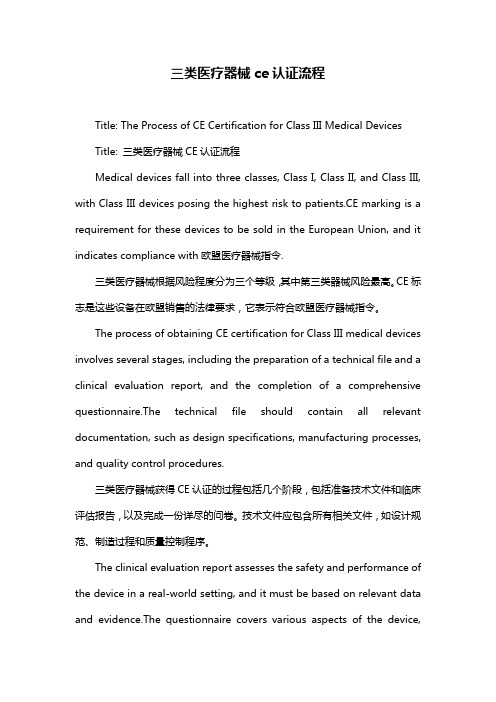
三类医疗器械ce认证流程Title: The Process of CE Certification for Class III Medical DevicesTitle: 三类医疗器械CE认证流程Medical devices fall into three classes, Class I, Class II, and Class III, with Class III devices posing the highest risk to patients.CE marking is a requirement for these devices to be sold in the European Union, and it indicates compliance with欧盟医疗器械指令.三类医疗器械根据风险程度分为三个等级,其中第三类器械风险最高。
CE标志是这些设备在欧盟销售的法律要求,它表示符合欧盟医疗器械指令。
The process of obtaining CE certification for Class III medical devices involves several stages, including the preparation of a technical file and a clinical evaluation report, and the completion of a comprehensive questionnaire.The technical file should contain all relevant documentation, such as design specifications, manufacturing processes, and quality control procedures.三类医疗器械获得CE认证的过程包括几个阶段,包括准备技术文件和临床评估报告,以及完成一份详尽的问卷。
供应商准入流程 英语

供应商准入流程英语The Supplier Onboarding ProcessEffective supplier onboarding is a critical component of successful supply chain management. It ensures that new suppliers are thoroughly vetted, meet the organization's requirements, and are properly integrated into the procurement process. The supplier onboarding process typically involves several key steps, each designed to evaluate the supplier's capabilities, compliance, and alignment with the company's goals.The first step in the supplier onboarding process is supplier identification and evaluation. This involves researching potential suppliers, reviewing their qualifications, and assessing their ability to meet the organization's needs. Factors such as the supplier's financial stability, technical capabilities, quality control measures, and past performance are carefully evaluated to determine their suitability.Once a potential supplier has been identified, the next step is the supplier approval process. This typically involves the completion of a comprehensive supplier questionnaire or application. Thequestionnaire collects detailed information about the supplier's business, including their legal structure, ownership, financial standing, and operational capabilities. The information provided is then thoroughly reviewed by the procurement team to ensure that the supplier meets the organization's requirements.In addition to the supplier questionnaire, the approval process may also include site visits and audits. These on-site assessments allow the procurement team to evaluate the supplier's facilities, manufacturing processes, and quality control measures firsthand. This helps to verify the information provided in the questionnaire and identify any potential areas of concern.Another critical aspect of the supplier onboarding process is the negotiation of the supplier contract. This involves establishing the terms and conditions of the business relationship, including pricing, delivery schedules, quality standards, and dispute resolution procedures. The contract serves as a legally binding agreement that outlines the responsibilities and expectations of both parties.Once the supplier contract has been finalized, the next step is supplier integration. This involves the implementation of processes and systems to facilitate seamless communication and collaboration between the organization and the supplier. This may include the establishment of electronic data interchange (EDI) systems, theintegration of the supplier's inventory management systems, and the implementation of joint planning and forecasting processes.Throughout the supplier onboarding process, ongoing supplier performance monitoring is essential. This involves the regular evaluation of the supplier's delivery, quality, and cost performance against pre-established metrics. The results of these evaluations are used to identify areas for improvement and to ensure that the supplier continues to meet the organization's requirements.In addition to performance monitoring, the supplier onboarding process also includes the management of supplier relationships. This involves regular communication, collaboration, and the provision of feedback to the supplier. By maintaining a strong, collaborative relationship with its suppliers, the organization can enhance its ability to respond to changing market conditions, mitigate supply chain risks, and drive continuous improvement.The supplier onboarding process is a critical component of effective supply chain management. By thoroughly vetting and integrating new suppliers, organizations can ensure that their procurement processes are aligned with their strategic objectives and that they are able to deliver high-quality products and services to their customers. Through ongoing performance monitoring and relationship management, organizations can further strengthen their supplierrelationships and drive continuous improvement throughout the supply chain.。
ResearchProjectProposal的研究的项目的计划

Research Project Proposal (generic template)This is a modified (expanded) version of a template used in:Iphofen, R. (2009) Ethical decision making in social research. A practical guide, London: Palgrave Macmillan – pages 200-04.This template may be copied and used for any research or teaching project subject to quoting the source.This template is designed to assist researchers to put together a project proposal. A good proposal should address or provide information on each of the elements outlined below. The amount of detail required will vary according to the precise research topic and the overall aims of the project. Research proposals should be written clearly and in such a way that an intelligent layperson can understand the principles involved. Any complex issues or technical terminology should be clarified for the benefit of research governance and ethics reviewers. The project proposal must offer enough information to clarify the project aims and methods, but not too much unnecessary or repetitive material. The proposal should demonstrate that the researcher fully understands the issues associated with the use of the proposed methods. It should indicate any known difficulties associated with applying those methods in the proposed setting. This document can then be used to …cut and paste‟ from the relevant fields into any other formal review forms as required.Reviewers’ CriteriaIn writing a proposal researchers would do well to remember the criteria that governance and ethics reviewers will have in mind when reading the proposal. They will be assessing throughout whether the project is …do-able‟. In simpleterms they should be thinking: can it be done, does it need to be done, can this person/these people do it, and can it be done in the way they are proposing? The overarching ethical question, which will be considered throughout the proposal, is: can it be done without harm to any of the people involved? The ultimate justification for a project must be: will it tell ussometh ing new and/or useful that we didn‟t already know?It is essential that full consideration is given to research ethics and this should be consistently demonstrated throughout the research proposal. If submission to a research ethics committee (REC) is required it should be made clear which REC will be reviewing the proposal. But ethical considerations should be embedded in research design from the outset and clearly indicated when necessary throughout the project proposal. Ethical concerns are related to the principles and values to be upheld whilst research is being conducted. The proposal must show throughout how the researchers intend to protect the rights, dignity, safety and well being of all actual or potential research participants –that includes …research subjects‟ as well as the researchers themselves. [After completing this proposal, go through it again using the “Ethics Review Checklist” to ensure key items have been attended to.]Provide:…a succinct and c lear project title[full title, short title and/ project nickname or acronym];…a clear statement of the research issue under investigation which……specifies the “research question” or questions AND…if appropriate, clarifies any “testable hypotheses”.[a short initial statement that makes the focus of the research clear] …some justification of the need for research to be conducted on this topic[explain if the research will fill a gap or meet a need – it might add toknowledge, deliver productive outcomes or add value for policy and/orpractice];…some discussion of existing information on the topic[at this stage a brief outline of the current state of knowledge – furtherjustification of the need for this research and which will be expandedlater in the full protocol];…an explanation of any secondary research that can/should be conducted[a brief statement of desk research or systematic literature review thatmay be required];…a rationale for conducting primary research[why new primary research is required];…an explanation of why the research needs to be condu cted in the chosen setting(s)[in particular, why the proposed subjects and/or setting are needed forthis research].This section combines the need for clear lines of responsibility and accountability together with a quick reference source for all those involved in the project. It also clarifies who is doing what and whether they can demonstrate the competencies necessary to accomplishing the research goal.Provide:…the name and contact details of the Principal Investigator (PI);…the names and contact details of all researchassistants/collaborators/partners in the project;…a clear indication of the research roles of all those involved in the project [the tasks/role allocated to each named individual];…brief, targeted CVs for PI, supervisor(s) and any collaborating researchers and partners; an indication of all researchers‟ experience or extra training if required[CVs help indicate any …track record‟ o f relevant experience in the field;acknowledge any gaps in competence (especially for noviceresearchers) and how these will be met];…a clarification of any advice or consultation that has been undertaken on project design such as peer review of the methodology;…names of sponsor and/or supervisor(s)[this may be a formal requirement for research governance];…any statement relating to research subjects‟ (service users, staff, carers etc.) participation in the design of the project.[making clear their precise tasks/role]A full research protocol must be provided explaining how and why the research is to be conducted.The protocol should contain:Literature review…an adequate review of the existing literature or previous research…c larification of whether the proposed study replicates prior work AND/OR …duplicates work done elsewhere…AND/OR…contains an element of originality.Methodology…an outline of and a rationale for the research design or approach taken;…details of the resea rch method(s) to be employed and any combinations of techniques or methods (e.g. a social survey employing a self-completion questionnaire);…it should be clearly indicated that the issues associated with the use of the methods being advocated are fully understood;…any difficulties associated with the use of the method(s) proposed are addressed by the prospective researcher;…details for any research instruments/measuring devices to be employed (e.g. questionnaires - copies of which need to be appended to the proposal; pre-validated and reliability-tested instruments offer a degree of security for the value of the research to be conducted and its comparative potential); …details of any baseline and outcome measures that will be taken;Participants…full ex planation of data collection procedures which sets out in detail: …any sampling strategy,…an explanation and justification for the sample size if sampling of apopulation is to be conducted,…any calculable power and effect sizes if appropriate,…the r ationale for any purposive or theoretical sampling provided.…an explanation of how research subjects might be systematically excluded from participation/selection dependent on sampling strategy or considerations for minimising anticipated harm to them, their group and/or their community; …full explanation of the procedure for gathering/collecting data;…full explanation of procedures for anonymising data and/or the maintenance of confidentiality if this is proposed;Data Storage and Protection…full expl anation of the procedure for storing data and whether the data will be retained or archived for secondary analysis. If data is to be disposed of details must be given for how and when this will happen....an assurance that the proposed project is compliant with the Data Protection Act, and how that assurance can be guaranteed.…a full explanation of the data analysis procedures that will be employed. Such as:…if qualitative data analysis is to be employed – an outline of theprocedure for coding/categorising data and if and how any datareduction will take place;…if quantitative data analysis is to be employed, an outline of theprocedure for grouping, collating and statistically testing datarelationships – specifying the tests to be used;…an outline of the use of any computer assisted data analysis (e.g.SPSS; NVivo) and how and why such methods are to be applied.…some evidence of ability to anticipate any potential sources of bias that could compromise the rigour and/or the objectivity of the project. Some detail about how these problems might be addressed if they arise.…an assessment of any potential for harm to individuals, groups or society and how this might be addressed. The types of harm to be assessed might include: psychological, physical, social, economic and legal; and consideration must be given as to whether the harm accrues from participation or systematic exclusion from participation. Some indication of how anticipated harms might be addressed should be supplied – together with a procedure for handling any complaints.…an assessment of the potential …vulnerability‟ of members of the research population and how this might be addressed;Project Timetable…a clear outline of the project timetable noting key stages in the project such as:…anticipated start and completion dates;…period of desk research and literature reviewing;…any pilot work or feasibility study;…the sequencing of interventions, baseline, outcome and evaluationmeasures;…the period set aside for data analysis and production of reports;…any anticipated obstacles to completing on schedule.[Insert GANTT and/or PERT charts or, at least, a simple tabulatedtimetable with the above items included showing awareness of theanticipated time needed to accomplish the given tasks.]…an outline of the anticipated benefits of conducting the research. These could be benefits to research subjects/participants, clients, service users, staff, government (local and national), the research site, the researcher(s) and/or the research organisation.…an explanation of any grounds for generalising the research findings beyond the immediate research site, organisation or subject group/population category being studied – e.g. regionally, across the UK, and/or internationally;…an outline of all intended forms of dissemination for the research findings to include:…an internal research report for funders/commissioners;…a public report (target numbers and audience specified);…press release to local/national media;…an assessed research dissertation or thesis;…conference/seminar presentations (local/national/international);…a self-published research report;…scholarly/professional journals.…an outline of any anticipated limitations to the public availability o f the project‟s findings.…clarification if research subjects (services users, clients, staff, carers etc.) will be involved in dissemination/implementation of research findings in any way; if not an explanation of why their inclusion is not necessary and/orunjustified; or if they are to be involved a rationale for why this would be of benefit.…an outline of how the research findings might help deliver better services, products or offer some improved value for money;…some consideration of whether the research will be of direct benefit to the research site in which it is being conducted – in the form of:…helping develop local research skills;…contributing to the research infrastructure in the organisation;…providing a basis for further research an d development;…result in ways in which management and professionals can improveservice/product delivery.…a discussion of the feasibility of implementing any findings in the research site, local community, more generally or other services.…an outline of any risks to researcher(s), subjects, organisations or the project as a whole that can be anticipated;…details of any risks to any collaborating social services group from permitting the project to be conducted (this includes the governance reviewing committee!);…a completed risk assessment form (append a completed “Project Risk Assessment Matrix”);…a specification of the system for recording and reporting any serious adverse events;…a specification of the indemnity/ins urance provision secured against any non-negligent harm. (Copies of certificates should be appended.)…a specification of the means whereby subjects (clients, service users, staff, members of the public etc.) will be informed of the nature of the project and precisely how the study will be described to potential participants (such as in the form of information leaflets and/or information letters; orscheduled/scripted oral descriptions; copies of these should be appended to the proposal).…an outline of the protocol for obtaining participants‟ consent to gathering data and to any further archiving or secondary data analysis (such as consent forms; again copies should be appended).[Consent can be gained in a variety of ways depending upon research design – so it need not be in the form of a written, signed andwitnessed consent form if such a procedure is deemed threatening orintimidating to participants or inhibitive of a valid methodology.]…specification of how the participants will be given “time to think” about whether they wish to participate; and how, if they wish to discontinue participation, this will be facilitated.…an outline of the lines of responsibility involved in the co nduct of the research.[An indication of who is accountable to whom in the form of anorganisational chart would help.]…a clear specification of the project “deliverables” (e.g. points of data collection and analysis, interim reports, final written report) and dates when they are due[Must be consistent with and match the timetable included earlier.]…evidence of the support of appropriate managers or gatekeepers etc. in the research site;[written letters of permission should be appended to the proposal or some statement of when and how such permission will be sought]…if this is research counting toward an education qualification there should be evidence of HEI approval, processing through HEI‟s governance and ethics procedure, in the form of a letter of approval including supervisor(s) details and signature(s).…evidence of CRB checks if required for the project and/or researchers‟ registration with the Independent Safeguarding Authority (ISA).A full budget document should detail the anticipated full costs of conducting the research and who (organisation or person) is actually funding the project.…an indication of the itemised expenditure on such things as:…human resources…equipment…travel…subsistence…accommodation…computer hardware/software.…an indication of the time that will be spent on the project by researchers and collaborators;…an indication of the source(s) of funding for the project.While the use of the “Ethic s Review Checklist” helps in anticipating and declaring ethical risks, the full proposal should offer clear evidence for the following:How valid consent from participants to take part in the study will be obtained.How the interests of and particularly …vulnerable‟ participants will be protected – such as the old, young people (children under 18 years), asylum seekers, prisoners, ethnic minorities and those with a disability. In the case of such participants special arrangements may have to be made to ensure valid consent and this may entail the use of proxies and/or gatekeepers.The procedure to be adopted if someone discloses something about their own or others‟ criminal actions and/or provides information about unprofessional behaviour.The procedure to be adopted if an action is uncovered that has detrimental consequences for individuals, groups, organisations or society.Familiarity with ethical guidelines on research produced by the researchers‟ own relevant professional associations (e.g. Social Research Association, British Sociological Association, British Psychological Society, Social Policy Association, UK Evaluation Society and so on).The medical research ethics principles contained in the Declaration of Helsinki (updated 2008) contain recommendations of value to social research, so reference to their implementation within the proposal will strengthen evidence for researchers‟ awareness of ethical concerns. In similar vein the International Commission on Healthcare‟s Good Clinical Practice guidelines must be followed if performing a clinical trial. The principles contained in this document could be applied to all practice-oriented studies and may be of use to any study adopting an experimental design with experimental and control groups within the social care field as well as in health and may, consequently, be relevant to a range of research in social and behavioural science.。
POSITION QUESTIONNAIRE
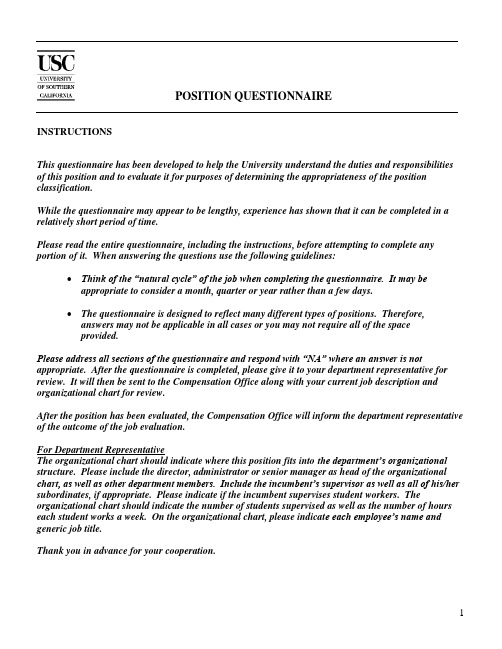
POSITION QUESTIONNAIREINSTRUCTIONSThis questionnaire has been developed to help the University understand the duties and responsibilities of this position and to evaluate it for purposes of determining the appropriateness of the position classification.While the questionnaire may appear to be lengthy, experience has shown that it can be completed in a relatively short period of time.Please read the entire questionnaire, including the instructions, before attempting to complete any portion of it. When answering the questions use the following guidelines:∙Think of the “natural cycle” of the job when completing the questionnaire. It may be appropriate to consider a month, quarter or year rather than a few days.∙The questionnaire is designed to reflect many different types of positions. Therefore, answers may not be applicable in all cases or you may not require all of the spaceprovided.Please address all sections of the questionnaire and respond with “NA” where an answer is not appropriate. After the questionnaire is completed, please give it to your department representative for review. It will then be sent to the Compensation Office along with your current job description and organizational chart for review.After the position has been evaluated, the Compensation Office will inform the department representative of the outcome of the job evaluation.For Department RepresentativeThe organizational chart should indicate where this position fits into the department’s organizational structure. Please include the director, administrator or senior manager as head of the organizational chart, as well as other department members. Include the incumbent’s supervisor as well as all of his/her subordinates, if appropriate. Please indicate if the incumbent supervises student workers. The organizational chart should indicate the number of students supervised as well as the number of hours each student works a week. On the organizational chart, please indicat e each employee’s name and generic job title.Thank you in advance for your cooperation.Your Name: _________________________________________________________________________Your Job Title:_______________________________________________________________________Your Internal Job Title: ______________________________________________________________Your Department Name: ____________________________________ Your Extension: ___________ Number of Employees in Department:_________________________Name of Your Supervisor: ________________________________________ Extension: ___________Education:Less than High School High School or Equivalent Specialized/Technical TrainingSome Related College Curriculum Associate’s Degree Bachelor’s DegreeMaster’s Degree Doctoral Degree Post Doctoral StudyCertificate/License _____________________________________________________________ Years of Experience in Field: ____________________________________________________________ Is the position responsible for managing a division, department, unit or program/project? If yes, name the division, department, program/project(s)?________________________________________________________________________________________________________________________________________ POSITION SUMMARY:What is the primary purpose of this job? Answer in the space provided. It may be easier to answer this question after completion of the questionnaire.______________________________________________________________________________________________ ______________________________________________________________________________________________ SIGNATURE OF EMPLOYEE ACKNOWLEDGING THE ACCURACY OF THIS DOCUMENT:__________________________________________________________________ Date: _____________________ SIGNATURE OF SUPERVISOR ACKNOWLEDGING THE REVIEW AND ACCURACY OF THISDOCUMENT:__________________________________________________________________ Date: _____________________QUESTION ONE: MAJOR JOB RESPONSIBILITIESWhat are your major job responsibilities? List each responsibility and indicate the appropriate percentage of total time spent in that responsibility. The sum of the percentages should equal 100%. Indicate the importance of each responsibility in the last column, using the key below.--------------------------------------------------------------*Key*1. Primary importance and highest priority*2. Secondary importance and priority*3. Lowest importance----------------------------------------------------------------------Responsibility % of Time Importance 1. _____________________________________________________________________________________ ________% ______________________________________________________________________________________________2. _____________________________________________________________________________________ _________% ______________________________________________________________________________________________3. _____________________________________________________________________________________ _________% _______________________________________________________________________________________________4. _____________________________________________________________________________________ _________% _______________________________________________________________________________________________5. _____________________________________________________________________________________ _________% _______________________________________________________________________________________________6. _____________________________________________________________________________________ _________% _______________________________________________________________________________________________7. _____________________________________________________________________________________ _________% _______________________________________________________________________________________________8. _____________________________________________________________________________________ _________% _______________________________________________________________________________________________9. _____________________________________________________________________________________ _________% _______________________________________________________________________________________________10. _____________________________________________________________________________________ _________% __________100%QUESTION TWO: PROBLEM SOLVINGGive examples of the types of problems you are expected to solve. How accessible is the information required to solvethese problems?------------------------------------------------------------Information Accessibility Key:(E)asy to obtain,(G)enerally available but some investigation necessary(D)ifficult to obtain and usually incomplete(V)ague or unavailable----------------------------------------------------------------Typical Problems to be Solved Accessibility _______________________________________________________________________ ______________________________________________________________________________ ______________________________________________________________________________ _______________________________________________________________________________ _______________________________________________________________________________ _______________________________________________________________________________ _______How often does the position require confronting problems that are not covered in the prescribed policies or guidelines?Daily Weekly Semi-Monthly Monthly InfrequentlyQUESTION THREE: DECISION MAKINGWhat major decisions are you regularly required to make? List the decision and indicate the type of guidance received inmaking the decision, such as departmental policies, professional knowledge and/or supervisory input. Specify how frequentlythe decision is made and its impact.**************************************************Frequency Key / Impact KeyD=Daily 1=Immediate work unitW=Weekly 2=Own school or departmentM=Monthly 3=Other schools or University departmentsQ=Quarterly 4=Entire UniversityA=Annually*************************************************In carrying out your duties, are you required to make independent choices, free from immediate supervision, as tomatters that significantly affect the University’s and/or department’s business? Yes NoFrequency/Decision Guidance Impact 1. _________________________________________________ _____________________________ _________________________________________________________________ _____________________________ ________________2. _________________________________________________ _____________________________ _________________________________________________________________ _____________________________ ________________3. _________________________________________________ _____________________________ _________________________________________________________________ _____________________________ ________________4. _________________________________________________ _____________________________ _________________________________________________________________ _____________________________ ________________5. _________________________________________________ _____________________________ _________________________________________________________________ _____________________________ ________________6. _________________________________________________ _____________________________ _________________________________________________________________ _____________________________ ________________Are you authorized to diverge from policies, guidelines and procedures without consulting a supervisor?Yes No If yes, give examples: _______________________________________________________________________________________________________________________________________________________________________Are you allowed to make decisions that would commit the division, department, or unit to spend a substantial amountof money or other resources? Yes No If yes, give examples of range of authorized spending: _________________________________________________________________________________________________________________________Do you serve as a specialist advisor to management with business decisions, which may significantly affectUniversity-wide or departmental operations or policies and procedures? If yes, explain: __________________________________________________________________________________________________________________________________QUESTION FOUR: BUDGET ADMINISTRATIONAre you responsible for developing, monitoring or administering an income and/or expense budget? Check the appropriate responses below to indicate the budget related responsibilities.Income Expense______ ______ No responsibility for developing or administering a budget______ ______ Gathers facts and figures used to develop a budget______ ______ Processes transactions______ ______ Tracks and reconciles budget activity______ ______ Analyzes variances and prepares status reports______ ______ Provides forecasts and projections used to develop a budget______ ______ Develops and administers a budgetBudgetary responsibilities are for a:___ Unit ___ School ___ Division ___ Program/Project ___ Department ___ University ___ OtherQUESTION FIVE: WORK GUIDANCE/SUPERVISION OF OTHERSCheck those statements that apply:___ I am not required to supervise or guide the work of other employees.WORK GUIDANCEWork Scheduling Personnel Administration___ Schedules and assigns work ___ Screens and interviews applicants___ Reviews or corrects work ___ Recommends new hires___ Maintains quality/quantity standards ___ Hires employees___ Provides input to performance appraisalsTraining___ Conducts performance appraisals___ Trains employees___ Recommends disciplinary actions___ Demonstrates techniques, equipmentor procedures to others ___ Initiates, enforces and monitors disciplinary actionsPolicy ___ Terminates employees___ Conveys established policies and ___ Recommends compensation increases or promotions procedures___ Approves compensation increases or promotions___ Interprets policies and procedures___ Approves policy exceptions___ Develops policies and procedures___ Implements policies and proceduresQUESTION SIX: SUPERVISION OF OTHERSHow many people do you supervise directly and indirectly? (For direct, count the number of people formally reporting to the position. For indirect, count the number of people reporting through someone who reports to this position.)Direct Indirect_____ Staff _____ Staff_____ Volunteers _____ Volunteers_____ Student/Work study _____ Student/Work study_____ Total _____ TotalQUESTION SEVEN: COMPUTER RELATED DUTIES (Information Technology positions only):1.Are you primarily a:Programmer Systems Analyst Software EngineerDatabase Administrator Other (specify): _______________________________2.Do your duties include design and development of (check all that apply):Applications Operating Systems NetworksOther (specify) _________________________________________________________Not involved in software or systems design3. If you checked more than one of the categories above, approximately what percentage of the time is devoted to each?Application Design _____% Operating Systems Design _____%Network Design _____% Other Design Work (specify) _____%Activities other than software or systems design _____%4. Are you required to consult directly with end users to determine hardware, software or system functional specifications?Yes No If yes, explain: __________________________________________________________________________________________________________________________________________________________________________________________________________________________________________________________________________________________________________________________________________________________5.Are you required to design, develop, document, test or modify computer systems or programs (including prototypes) basedon existing specifications established by others? Yes No If yes, explain:____________________________________________________________________________________________________________________________________________________________________________________________________ __________________________________________________________________________________________________THANK YOUFOR COMPLETING THE QUESTIONNAIRE。
如何用STAR法则来回答「宝洁八大问」
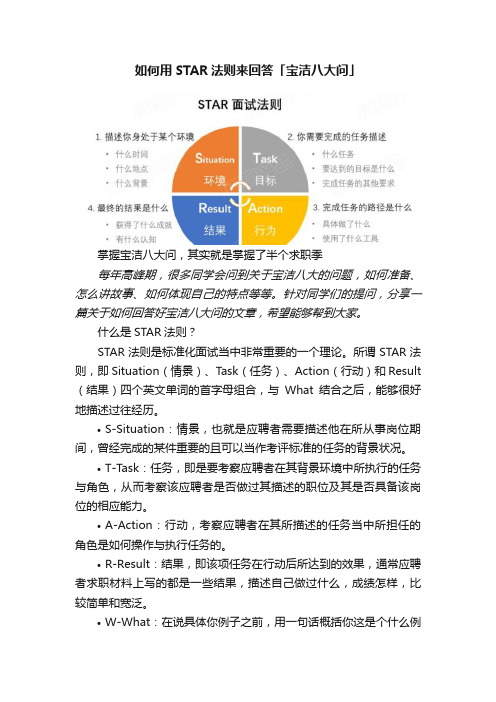
如何用STAR法则来回答「宝洁八大问」掌握宝洁八大问,其实就是掌握了半个求职季每年高峰期,很多同学会问到关于宝洁八大的问题,如何准备、怎么讲故事、如何体现自己的特点等等。
针对同学们的提问,分享一篇关于如何回答好宝洁八大问的文章,希望能够帮到大家。
什么是STAR法则?STAR法则是标准化面试当中非常重要的一个理论。
所谓STAR法则,即Situation(情景)、Task(任务)、Action(行动)和Result (结果)四个英文单词的首字母组合,与What结合之后,能够很好地描述过往经历。
•S-Situation:情景,也就是应聘者需要描述他在所从事岗位期间,曾经完成的某件重要的且可以当作考评标准的任务的背景状况。
•T-Task:任务,即是要考察应聘者在其背景环境中所执行的任务与角色,从而考察该应聘者是否做过其描述的职位及其是否具备该岗位的相应能力。
•A-Action:行动,考察应聘者在其所描述的任务当中所担任的角色是如何操作与执行任务的。
•R-Result:结果,即该项任务在行动后所达到的效果,通常应聘者求职材料上写的都是一些结果,描述自己做过什么,成绩怎样,比较简单和宽泛。
•W-What:在说具体你例子之前,用一句话概括你这是个什么例子,比如我举一个通过XXX最后XXX的例子,一句话就够了,言简意赅。
按照STAR的逻辑框架,详略得当地讲述,最重点也是占篇幅最大的肯定是A-Action,需要分点讲述;STR都是比较简短的部分,注意利用客观事实和数字等依据去描述;另外,不要讲到某一部分就拘泥于细节无法自拔,记得推进例子的发展。
什么是宝洁8大问?或许有很多小伙伴还不知道什么是宝洁八大问。
宝洁八大问是宝洁公司人力资源专家精心设计的八大核心问题,这八个核心问题的具体内容如下:①举例说明,你如何制定了一个很高的目标,并且最终实现了它。
②请举例说明你在一项团队活动中如何采取主动性,并且起到领导者的作用,最终获得你所希望的结果。
行政管理英语
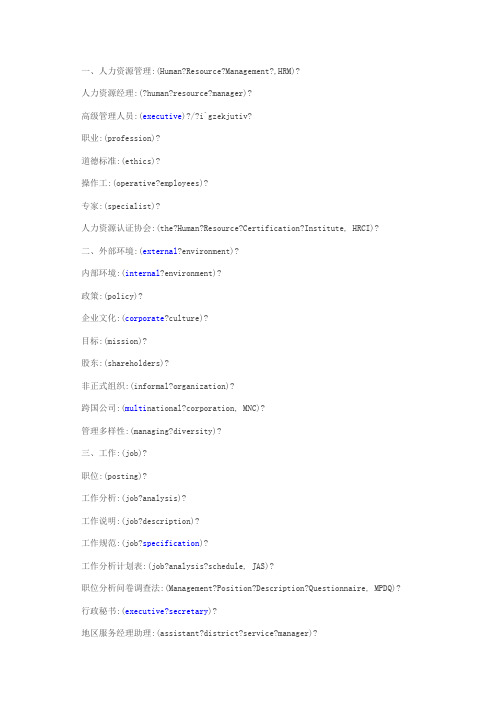
一、人力资源管理:(Human?Resource?Management?,HRM)?人力资源经理:(?human?resource?manager)?高级管理人员:(executive)?/?i`gzekjutiv?职业:(profession)?道德标准:(ethics)?操作工:(operative?employees)?专家:(specialist)?人力资源认证协会:(the?Human?Resource?Certification?Institute, HRCI)?二、外部环境:(external?environment)?内部环境:(internal?environment)?政策:(policy)?企业文化:(corporate?culture)?目标:(mission)?股东:(shareholders)?非正式组织:(informal?organization)?跨国公司:(multi national?corporation, MNC)?管理多样性:(managing?diversity)?三、工作:(job)?职位:(posting)?工作分析:(job?analysis)?工作说明:(job?description)?工作规范:(job?specification)?工作分析计划表:(job?analysis?schedule, JAS)?职位分析问卷调查法:(Management?Position?Description?Questionnaire, MPDQ)? 行政秘书:(executive?secretary)?地区服务经理助理:(assistant?district?service?manager)?四、人力资源计划:(Human?Resource?Planning,HRP)?战略规划:(strategic?planning)?长期趋势:(long?term?trend)?要求预测:(requirement?forecast)?供给预测:(availability?forecast)?管理人力储备:(management?inventory)?裁减:(downsizing)?人力资源信息系统:(Human?Resource?Information?System,HRIS)?五、招聘:(recruitment)?员工申请表:(employee?requisition)?招聘方法:(recruitment?methods)?内部提升:(Promotion?From?Within?,PFW)?工作公告:(job?posting)?广告:(advertising)?职业介绍所:(employment?agency)?特殊事件:(special?events)?实习:(internship)?六、选择:(selection)?选择率:(selection?rate)?简历:(resume)?标准化:(standardization)?有效性:(validity)?客观性:(objectivity)?规范:(norm)?录用分数线:(cutoff?score)?准确度:(aiming)?业务知识测试:(job?knowledge?tests)?求职面试:(employment?interview)?非结构化面试:(unstructured?interview)?结构化面试:(structured?interview)?小组面试:(group?interview)?职业兴趣测试:(vocational?interest?tests)?会议型面试:(board?interview)?七、组织变化与人力资源开发?人力资源开发:(Human?Resource?Development,HRD)? 培训:(training)?开发:(development)?定位:(orientation)?训练:(coaching)?辅导:(mentoring)?经营管理策略:(business?games)?案例研究:(case?study)?会议方法:(conference?method)?角色扮演:(role?playing)?工作轮换:(job?rotating)?在职培训:(on-the-job?training?,OJT)?媒介:(media)?八、企业文化与组织发展?企业文化:(corporate?culture)?组织发展:(organization?development,OD)?调查反馈:(survey?feedback)?质量圈:(quality?circles)?目标管理:(management?by?objective,MBO)?全面质量管理:(Total?Quality?Management,TQM)? 团队建设:(team?building)?九、职业计划与发展?职业:(career)?职业计划:(career?planning)?职业道路:(career?path)?职业发展:(career?development)?自我评价:(self-assessment)?职业动机:(career?anchors)?十、绩效评价?绩效评价:(Performance?Appraisal,PA)?小组评价:(group?appraisal)?业绩评定表:(rating?scales?method)?关键事件法:(critical?incident?method)?排列法:(ranking?method)?平行比较法:(paired?comparison)?硬性分布法:(forced?distribution?method)?晕圈错误:(halo?error)?宽松:(leniency)?严格:(strictness)?3600反馈:(360-degree?feedback)?叙述法:(essay?method)?集中趋势:(central?tendency)?十一、报酬与福利?报酬:(compensation)?直接经济报酬:(direct?financial?compensation)?间接经济报酬:(indirect?financial?compensation)?非经济报酬:(no?financial?compensation)?公平:(equity)?外部公平:(external?equity)?内部公平:(internal?equity)?员工公平:(employee?equity)?小组公平:(team?equity)?工资水平领先者:(pay?leaders)?现行工资率:(going?rate)?工资水平居后者:(pay?followers)?劳动力市场:(labor?market)?工作评价:(job?evaluation)?排列法:(ranking?method)?分类法:(classification?method)?因素比较法:(factor?comparison?method)?评分法:(point?method)?海氏指示图表个人能力分析法:(Hay?Guide?Chart-profile?Method)? 工作定价:(job?pricing)?工资等级:(pay?grade)?工资曲线:(wage?curve)?工资幅度:(pay?range)?十二、福利和其它报酬问题?福利(间接经济补偿)?员工股权计划:(employee?stock?ownership?plan,ESOP)?值班津贴:(shift?differential)?奖金:(incentive?compensation)?分红制:(profit?sharing)?十三、安全与健康的工作环境?安全:(safety)?健康:(health)?频率:(frequency?rate)?紧张:(stress)?角色冲突:(role?conflict)?催眠法:(hypnosis)?酗酒:(alcoholism)?十四、员工和劳动关系?工会:(union)?地方工会:(local?union)?行业工会:(craft?union)?产业工会:(industrial?union)?全国工会:(national?union)?谈判组:(bargaining?union)?劳资谈判:(collective?bargaining)?仲裁:(arbitration)?罢工:(strike)?内部员工关系:(internal?employee?relations)? 纪律:(discipline)?纪律处分:(disciplinary?action)?申诉:(grievance)?降职:(demotion)?调动:(transfer)?晋升:(promotion)ABC?Activity?Based?Costing?基于活动的成本核算?ABM?Activity?Based?Management?基于活动的管理?ACWP?Actual?Cost?of?Work?Performed?已完成工作实际成本? ADM?Arrow?Diagram?Method?箭线图方法?ADP?Automated?Data?Processing?自动化数据处理?ADR?Alternative?Dispute?Resolution?替代争议解决方案?AF?Actual?Finish?Date?实际完成日期?AFE?Application?for?Expenditure?支出申请?AFE?Authority?for?Expenditure?开支权?ALAP?As-Late-As-Possible?尽可能晚?AMR?Advanced?Material?Release?材料提前发布?AOA?Activity?on?Arc?弧线表示活动双代号网络?AOA?Activity?on?Arrow?箭线表示活动双代号网络?AON?Activity?on?Node?节点表示活动单代号网络?AOQ?Average?Outgoing?Quality?平均出厂质量AOQL?Average?Outgoing?Quality?Limit?平均出厂质量限度APMA?Area?of?Project?Management?Application?项目管理的应用领域APR?Acquisition?Plan?Review?采购计划评审AQL?Acceptable?Quality?Level?可接受质量水平AS?Actual?Start?Date?实际开始日期ASAP?As-Soon-As-Possible?尽快ATP?Acceptance?Test?Procedure?验收测试过程AUW?Authorized?Unpriced?Work?批准的未定价工作?BAC?Budget?at?Completion?完工预算BAC?Baseline?at?Completion?完成/完工基线BATNA?Best?Alternative?to?Negotiated?Agreement?协议外最佳方案BCM?Business?Change?Manager?商业变更经理BCWP?Budgeted?Cost?of?Work?Performed?已完工作预算成本BCWS?Budgeted?Cost?of?Work?Scheduled?计划工作的预算成本BEC?Elapsed?Cost?计划工作的预算成本BOOT?Build,?Own,?Operate,?Transfer?建造拥有经营转让BPA?Blanket?Purchase?Agreement?一揽子采购协议BSA?Balanced?Scorecard?Approach?平衡记分卡方法C/SCSC?Cost/Schedule?Control?System?Criteria?成本控制系统标准C/SSR?Cost/Schedule?Status?Report?成本/进度状态报告CA?Control?Account?控制帐目CAD?Computer?Aided?Drafting/Design?计算机辅助制图/设计CAM?Cost?Account?Manager?成本帐目经理CAM?Computer?Aided?Manufacturing?计算机辅助制造CAM?Control?Account?Manager?控制帐目经理CAP?Cost?Account?Plan?成本帐目计划CAP?Control?Account?Plan?控制帐目计划CAR?Capital?Appropriation?Request?资本划拨请求CBD?Component-Based?Development?基于构件的开发CBS?Cost?Breakdown?Structure?成本分解结构CCB?Change?Control?Board?变更管理委员会CCDR?Contractor?Cost?Data?Report?承包商成本数据报告CDR?Critical?Design?Review?关键设计评审CI?Configuration?Item?配置项CM?Configuration?Management/Construction?Management?配置管理/施工管理CPFFC?Cost?Plus?Fixed?Fee?Contract?成本加固定费用合同CPI?Cost?Performance?Index?成本绩效指数CPI?Cost?Performance?Indicator?成本绩效指数CPIFC?Cost?Plus?Incentive?Fee?Contract?成本加奖励费用合同CPM?Critical?Path?Method?关键路径法CPN?Critical?Path?Network?关键路径网络图CPPC?Cost?Plus?Percentage?of?Cost?Contract?成本加成本百分比合同CPR?Cost?Performance?Ratio?成本绩效比率CPR?Cost?Performance?Report?成本绩效报告CPU?Central?Processing?Unit?中央处理单元CR?Change?Request?变更请求CSCI?Computer?Software?Configuration?Item?计算机软件配置CSF?Critical?Success?Factors?关键的成功因素CTC?Contract?Target?Cost?合同目标成本CTP?Contract?Target?Price?合同目标价格CTR?Cost-Time?Resource?Sheet?成本时间资源表CV?Cost?Variance?成本偏差CWBS?Contract?Work?Breakdown?Structure?合同工作分解结构DBA?Database?Administrator?数据库管理员DBM?Dynamic?Baseline?Model?动态基线模型DBMS?Database?Management?System?数据库管理系统DCE?Distributed?Computing?Environment?分布式计算环境DCF?Discounted?Cash?Flow?折现现金流DD?Data?Date?数据日期DID?Data?Item?Description?工作项描述DRD?documentation?Requirements?Description?文档要求说明DU?Duration?工期持续时间EAC?Estimated?Actual?at?Completion?实际完工估算ECC?Estimated?Cost?to?Complete?尚未完成的成本估算ECP?Engineering?Change?Proposal?工程变更建议书EF?Early?Finish?Date?最早完成日期EFC?Estimated?Final?Cost?估算的最终成本EMR?Expenditure?Management?Report?支出管理报告EPS?Enterprise?Project?Structure?企业项目结构ERP?Enterprise?Resource?Planning?企业资源规划ERPS?Enterprise?Resource?Planning?Systems?企业资源规划系统ES?Early?Start?Date?最早开始日期ESAR?Extended?Subsequent?Applications?Review?扩展后续应用评审ETC?Estimate?To?Complete?尚未完成/完工的估算EV?Expected?value?期望值EVMS?Earned?value?Management?System?挣值管理系统FAC?Forecast?At?Completion?完工预测FF?Free?Float?自由浮动时间FFP?Firm?Fixed?Price?Contract?严格固定价格合同FIFO?First?In,?First?Out?先进先出FM?Functional?Manager?职能经理FP?Fixed?Price?Contract?固定价格合同FPPIF?Fixed?Price?Plus?Incentive?Fee?Contract?固定价格加激励酬FTC?Forecast?to?Completion?完工尚需预测FTP?File?Transfer?Protocol?文件传输协议G&A?General?and?Administrative?Costs?综合行政管理成本G&A?General?and?Administrative?综合行政管理费GAAP?Generally?Accepted?Accounting?Principles?公认会计原则GERT?Graphical?Evaluation?and?Review?Technique?图形评审技术GUI?Graphical?User?Interface?图形用户界面企业管理AAccounting?service(cooperate?with?partner)?会计服务Accounting?system?designing?会计系统设计Administrator/employer?组织Adviser/advisor?顾问Assets?evaluation?资产评估Assistant?manger?审计Auditing?监事AuditorBBoard?董事会Board?director?董事Branch?manager?分公司经理Branch?office?分公司Business?administration?管理者,经营者Business?&?governmental?relationship?&coordination?行业及政府关系协调Business?office?办事处Business?restructuring?企业重组Business?strategy?designing?&?implementation?企业战略的制订和实施CChairmen?董事长Chief/section?chief?主任Company?doctor?services?企业诊断Company?group?set-up?企业集团化设计Competition?analysis?竞争环境分析Conglomerate?企业集团Consul?领事Consumer?behavior?study?消费者行为研究Corporate?financing?企业融资Corporate?law?公司法Corporate?planning?department(division)?(合并多家不同企业所组成的)关系企业Cross-boarder?investment?consulting?海外投资咨询DDepartment部门Deputy?director?副处,副主任Deputy?general?manger?副总经理Deputy?manager?副经理Director处长,主任Distribution?&?sale?channel?analysis?销售渠道调查?Domestic?sales?department(division)?国内销售部EEmployee?雇员(从业人员)Evaluation?&?selection?of?partners?合作伙伴的评价和选择Executive?执行董事,总经理,行政长官Executive?director,?chief?executive?officer(CEO)?董事代表FFeasibility?study项目可行性研究GGeneral?accounting?department(division)?会计部,财务部General?affairs?department(division)?总务部General?manage?总经理rGovernment(national)enterprise?国营企业HHead?office?总公司IIndustry?research?&?analysis?行业调查与分析Intellectual?property?right?protection?知识产权保护Investment?consultancy?投资咨询Investment?&?financing?投资和融资Investment?fund?advice?投资基金顾问Investment?opportunity?&?risk?analysis?投资机会研究和投资风险分析LLaboratory?实验室Legal?services(cooperate?with?partner)?法律服务Litigation?&?arbitration?诉讼和仲裁MM?&?A?企业兼并,收购Major?organization?主要部门Management?consultancy?管理咨询Manager?经理Managing?director?常务董事Manufacturers?survey?生产厂家调查Market?entry?&?expansion?市场进入和扩展Market?research?市场调查Middle-level?manager?中层管理人员Multinational?enterprise?跨国企业OOverseas?distribution?海外销售部Overseas?planning?department?(division)?海外业务部PParent?company母公司Personnel?department(division)?人事部Plant?制造工厂Plant?manager?工厂President主席,董事长Private?enterprise私营企业Product?development?department(division)?商品开发部Product?study?产品研究Project?evaluation?项目评估Project?financing?consulting?项目融资咨询Project?manager?项目经理Public?relations?department(division)?公共关系部RReal?estate?房地产registered?capital?注册资本regulatory?policy?study?政策研究SSales?administration?department(division)销售管理部Sales?department?销售部Secretariat?秘书处Section/division?科,室Section?chief?科长Securities?law?证券法Senior?managing?director?高级董事Share-holding?corporation?designing?股份制改造策划Shareholders?投资者Small?and?medium-size?businesses(enterprises)?中小企业Small?business?小型企业Storage保管,贮藏Strategy?consultancy?战略咨询Subsidiary?子公司TTaxation?税务Taxation?agency?&?advisory?service?税务代理与咨询WWarehouse?仓库Welfare?facilities?福利设施总公司Head Office (HO)分公司Branch Office (BO)营业部Business Office (BO)人事部Personnel Department (PD)人力资源部Human Resources Department (HR)总务部General Affairs Department (GAD)财务部General Accounting Department (GA)销售部Sales Department (SD)促销部Sales Promotion Department (SPD)国际部International Department (ID)出口部Export Department (ED)进口部Import Department (ID)公共关系Public Relations Department (PD)广告部Advertising Department (AD)企划部Planning Department (PD)产品开发部Product Development Department (PDD)研发部Research and Development Department(R&D) (RDD) 秘书室Secretarial Pool (SP)采购部Purchasing Department (PD)工程部Engineering Department (ED)行政部Admin. Department (AD)人力资源部HR Department (HR)市场部Marketing Department (MD)技术部Technolog Department (TD)客服部Service Department (SD)行政部: Administration (AD)财务部Financial Department (FD)总经理室、Direcotor, or President (DP)副总经理室、Deputy Director, or Vice president (DD) 总经办、General Deparment (GD)采购部、Purchase & Order Department (POD) 工程部、Engineering Deparment (ED)研发部、Research Deparment (RD)生产部、Productive Department (PD)销售部、Sales Deparment (SD)广东业务部、GD Branch Deparment (GD)无线事业部、Wireless Industry Department (WD) 拓展部Business Expending Department (BED) 物供部、Supply Department (SD)B&D business and development 业务拓展部Marketing 市场部Sales 销售部HR 人力资源部Account 会计部PR people relationship 公共关系部OFC (Office, 但不常见) / OMB = Office of Management and Budget 办公室Finance 财务部MKTG (Marketing) 市场部R&D (Research & Development) 研发部MFG (Manufacturing) 产品部。
oea[雅思]雅思听力十大场景及高频词
![oea[雅思]雅思听力十大场景及高频词](https://img.taocdn.com/s3/m/45c05ad7a0c7aa00b52acfc789eb172ded639986.png)
十大典型的听力场景生活类-----(1)住房和住宿场景(2)地理场景taking about hometown(3)旅游场景(4)日常场景:活动日程安排银行(5)新生报到场景,(6)图书馆场景学术类-----(7)选课场景,科目,学科,(8)课题研究场景(9)环保场景(10)授课场景租房篇特点:这个部分也是最容易丢分的,因为其琐碎性导致.1. 对话人物比较简单:对话双方为租房房客(tenant),房东(landlord/landlady),或者房屋代理中介(house agent)2. 对话内容信息比较集中:住宿类型、租金、房间设施、租房/住宿要求等等考点:1. 专业词汇的拼写,例如,房子类型,房间设施、家电、家具等2. 数字的准确认读和听写常用的词汇:住宿:housing accommodation房子类型:flat, apartment, dormitory(dorm), student hotel, youth hostel,basement Homestead 一居室studio房子家电或设施:balcony garden bedroom, kitchen, entrance hall --lobby –porch living room 带家具furnished 洗衣laundry toasterstove, fridge, microwave oven, washing machine, air-condition, electric fans, radiator, electric stoves,vacuum cleaner,water heater 卫星电视satellite tv床上用品:Pillow, pillow case, bed linen, sheet, mattress, blanket, towel房子位置:Road (rd.), street (st.) Lane avenue rural -urban area central租金和帐单:rent ,deposit,telephone bill, gas bill ,water/electricity bill pay on monthly basis weekly maximum minimum饮食要求:vegetarian snacks refreshment beverage no spicy no nuts入住时间time available星期mon tue wed thur fri sat sun月份jan证件passport id card bank statement student id visa语言水平elementary primary secondary intermediate advanced房东的要求pets children支付方式cash credit card check debit card各国钱币dollar pound penny yen euro Australian dollar Canadian dollar 电话考点double check 分节33 34 44 等double交通工具cab subway underground tube van coach mini-bus旅游场景它多以填空题和选择题的题型出现notes/table/summary/flow-chart/sentence completion这几种题型.涉及考点:目的地,交通工具,费用及支付方式,语言,景点的讲解,活动,注意事项,携带物品,旅行社,时间,住宿,同行者,某人去不了的原因.各个考点的相关词汇目的地cities, mountains, deserts沙漠,hilly areas丘陵地带,wetlands沼泽地,bush land灌木丛,tropical rain forests热带雨林,resorts胜地,beaches, coastal areas沿海地区, 乡村(village)、瀑布(water fall)river, lake,交通工具public transport公共交通,private transport私人交通,car, airplane, ferry渡船,underground/subway/tube/Metro地铁,river cruise巡游,费用及支付方式book the room(make a reservation)订房间, currency货币,Canadian dollars加元,Australian dollars, Pounds镑, Japanese Y en日元,credit card信用卡(V isa维萨卡, MasterCard万事达, American Express美国运通)语言French法语, Cantonese粤语, Mandarin普通话, Russian俄语, Italian意大利语, German德语, Portuguese葡萄牙, Japanese日语, Arabic阿拉伯语景点Hot spring温泉,fountain泉水,喷泉,beaches海滩,spotlight tour聚光灯旅行,four-wheel drive四驱车,crocodile cruise, waterfalls瀑布,castle城堡,museum 博物馆,art gallery 画廊英国和澳洲常见景点活动swimming, diving潜水,跳水,Scuba Diving器械潜水,surfing冲浪,water skiing滑水,hang gliding悬挂滑翔,water polo水球, skiing 滑雪,hiking 徒步旅行,bag-packer 肩背大包进行自助旅行的人,hitch-hike 搭便车旅行。
优秀大学生英语自我介绍简短五篇
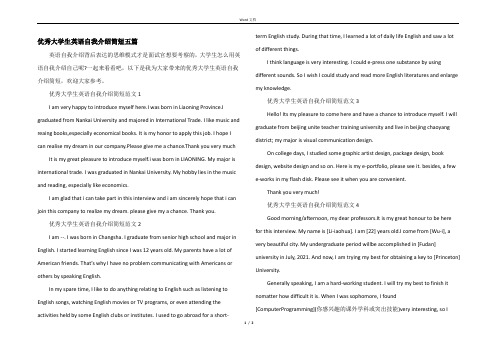
优秀大学生英语自我介绍简短五篇英语自我介绍背后表达的思维模式才是面试官想要考察的,大学生怎么用英语自我介绍自己呢?一起来看看吧,以下是我为大家带来的优秀大学生英语自我介绍简短,欢迎大家参考。
优秀大学生英语自我介绍简短范文1I am very happy to introduce myself here.I was born in Liaoning Province.I graduated from Nankai University and majored in International Trade. I like music and reaing books,especially economical books. It is my honor to apply this job. I hope I can realise my dream in our company.Please give me a chance.Thank you very much It is my great pleasure to introduce myself.i was born in LIAONING. My major is international trade. I was graduated in Nankai University. My hobby lies in the music and reading, especially like economics.I am glad that i can take part in this interview and i am sincerely hope that i can join this company to realize my dream. please give my a chance. Thank you.优秀大学生英语自我介绍简短范文2I am --. I was born in Changsha. I graduate from senior high school and major in English. I started learning English since I was 12 years old. My parents have a lot of American friends. That’s why I have no problem communicating with Americans or others by speaking English.In my spare time, I like to do anything relating to English such as listening to English songs, watching English movies or TV programs, or even attending the activities held by some English clubs or institutes. I used to go abroad for a short-term English study. During that time, I learned a lot of daily life English and saw a lot of different things.I think language is very interesting. I could e-press one substance by usingdifferent sounds. So I wish I could study and read more English literatures and enlarge my knowledge.优秀大学生英语自我介绍简短范文3Hello! Its my pleasure to come here and have a chance to introduce myself. I will graduate from beijing unite teacher training university and live in beijing chaoyang district; my major is visual communication design.On college days, I studied some graphic artist design, package design, book design, website design and so on. Here is my e-portfolio, please see it. besides, a few e-works in my flash disk. Please see it when you are convenient.Thank you very much!优秀大学生英语自我介绍简短范文4Good morning/afternoon, my dear professors.It is my great honour to be here for this interview. My name is [Li-iaohua]. I am [22] years old.I come from [Wu-i], a very beautiful city. My undergraduate period willbe accomplished in [Fudan]university in July, 2021. And now, I am trying my best for obtaining a key to [Princeton] University.Generally speaking, I am a hard-working student. I will try my best to finish it nomatter how difficult it is. When I was sophomore, I found[ComputerProgramming](你感兴趣的课外学科或突出技能)very interesting, so I1/ 2learned it very hard. To weave a homepage for myself, I stayed with my personal computer for half a month,and I am the first one in my class who own his homepage.Furthermore, I am a person with great perseverance. During the days preparing for the first e-amination(Entrance e-aminations to postgraduate商量生入学考试可以简略表达),I insist on running every day,no matter what the weather was like. And just owning to this, I could concentrate on my study and succeeded in the end.Well, in my spare time, I like[basketball, tennis and Chinese chess]. Also, English is my favorite.I often go to English corner to practice my oral English on every Thursday, and write compositions to improve my written ability. But I know my English is not good enough, I will continue studyinOk,that’s all, thank you.优秀大学生英语自我介绍简短范文5I am from the School of Economics, Lu Wenjie. Time flies, time flies and leave the immature freshman, sophomores confused, today I am a little more mature and stable. Looking back over the past two years, both full of challenges and hard work, but also frustration and regret. However, the 1000 Amoy 10 000 strain liquids while hard, Chuijin Once Upon a beginning to the gold. Two years I work hard with their own, with their own hard work and sweat, with his down-to themselves, to parents, the teachers submitted a satisfactory answer.The most profound memory of my winter vacation this year alone to Jiang-i Province to investigate the small Tamura, combined with the theory, in-depth and detailed analysis of the collected raw data and materials, to complete a small Tamura Basic economic and social development research, was Ninth Challenge Cupe-tra-curricular academic and scientific work of Tianjin College of Philosophy andSocial Science Class Grand Prize competition, Challenge Cup of Tianjin Science and Technology Business School E-tracurricular academic works of philosophy and social science contest first prize. Completion of such a comple- investigation, and ultimately, the difficulties in the rocky course of the investigation, the investigations success is also dedicated to pay two years of university life results.Sophomore year, gradually increasing professional courses in the learning process, I came to feel that the present study only stick to te-tbooks, but only with real-life learning is linked to a deeper understanding. Three Rural Issues is currently one of Chinas economic development priorities and difficult problems. I have strong concern for the issue, and in order to learn more about the real life of villagers incentral position, and the current series of agriculture-related policies to the changes brought about in rural areas. I selected for the micro-sample of Jiang-i Province,Tamura D, carry out investigations. As never before been investigated by learningeverything from scratch, starting from scratch. First access to the rural economyliterature to understand the current situation in rural areas around, and the basicform of the report, then, for my topic, design the questionnaire. At that time, tocoincide with the final e-amination of the review stage, and I have to step up review.Can be said that every day is the first quarters out, go back to the latest one.2/ 2。
补全对话英语怎么说
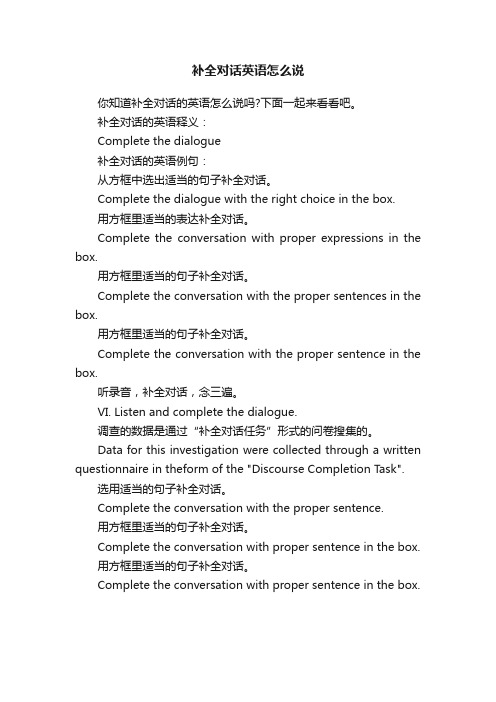
补全对话英语怎么说你知道补全对话的英语怎么说吗?下面一起来看看吧。
补全对话的英语释义:Complete the dialogue补全对话的英语例句:从方框中选出适当的句子补全对话。
Complete the dialogue with the right choice in the box.用方框里适当的表达补全对话。
Complete the conversation with proper expressions in the box.用方框里适当的句子补全对话。
Complete the conversation with the proper sentences in the box.用方框里适当的句子补全对话。
Complete the conversation with the proper sentence in the box.听录音,补全对话,念三遍。
VI. Listen and complete the dialogue.调查的数据是通过“补全对话任务”形式的问卷搜集的。
Data for this investigation were collected through a written questionnaire in theform of the "Discourse Completion Task".选用适当的句子补全对话。
Complete the conversation with the proper sentence.用方框里适当的句子补全对话。
Complete the conversation with proper sentence in the box.用方框里适当的句子补全对话。
Complete the conversation with proper sentence in the box.。
- 1、下载文档前请自行甄别文档内容的完整性,平台不提供额外的编辑、内容补充、找答案等附加服务。
- 2、"仅部分预览"的文档,不可在线预览部分如存在完整性等问题,可反馈申请退款(可完整预览的文档不适用该条件!)。
- 3、如文档侵犯您的权益,请联系客服反馈,我们会尽快为您处理(人工客服工作时间:9:00-18:30)。
Environment Infrastructure/Architecture
Assets
Resources
Sponsor Commitment
Sponsor Communication
Sponsor Capability Change Agent Commitment Change Agent Communication
Programs
Timing External Relationships Products & Services Processes & Functions
Interfaces
Information Technology Resources Organization
Inter-Relationships
Stakeholders Stakeholders Stakeholders Stakeholders Business Plan Business Plan Business Plan Business Plan Business Plan Business Plan
Environment Business Plan
Portability
Coupling Scalability Flexibility Localizability Economic Impact Competitive Advantage Strategic Fit Competitive Risk Project Risk Roles & Responsibilities
Area
Stakeholder One Stakeholder Two Stakeholder Three Stakeholder Four Stakeholder Five Stakeholder Six
current conditions that necessitate a change business opportunity or need business goals & objectives business worth - how much organization is willing to spend required functions, features & capabilities planned benefits - tangible & intangible locations affected by change target completion dates & rationale for releases & total project proposed business phasing & staging opportunities & priorities for delivering required capability assumptions & constraints applicable to the planned project anticipated volumes, mix & peak periods for selected activities authorizations required for existing & new processes & activities audit trail requirements for existing & new processes & activities requirements for accuracy & completeness of information requirements for sustaining processing if problems occur service level objectives for all affected services access control requirements for physical, information & human resource assets objectives for legislative, regulatory and corporate compliance objectives for effort required to learn & use by service & target users requirements for transferring function across environments (e.g., laptop, PDA, cell phone) requirements for interfacing with other processes or functions requirement for handling changing volumes & complexities over time requirements for changing function and capability requirements for different languages, cultures & conventions the payback delivered by the change value derived from new business strategy, product or service degree to which project supports stated strategic goals degree to which failure to do the project will cause competitive damage. project & organizational risk as it relates to this change primary stakeholders & their roles & responsibilities
expectations 5 - Far exceeded goals &
expectations
Accountability
Mark an "X" below the Stakeholder most accountable for each Decision
Area
Stakeholder One Stakeholder Two Stakeholder Three Stakeholder Four Stakeholder Five Stakeholder Six
Description
Responses
1 - Did not meet goals & expectations or don't know 2 - Generally met goals &
expectations 3 - Completely met goals &
expectations 4 - Exceeded goals &
Skills & Capacity
sponsors' commitment to this change sponsors' ability to communicate rationale & objectives of this change in a manner that encourages direct feedback sponsors' history of successfully implementing change change agents' commitment to this change change agents' ability to identify & manage resistance change agents' ability to understand targets' perspectives & needs and generate a high level of teamwork targets' level of understanding about why change is being implemented targets' understanding about what is specifically expected from them targets' ability to effectively support the change effort skills required in each target group and the gaps that need to be addressed why organization exists & how planned change supports this what organization wants to achieve & how planned change supports this what organization believes in & how planned change supports this how organization will achieve vision & how planned change supports this what organization will do, when & how planned change supports this impact of proposed change on high level dependencies among planned ionpitpiaotritvuensities to bundle this change with others to optimize value & reduce cost & risk. impact of proposed change on timing for each initiative over plan horizon impact of proposed change on current & planned external relationships impact of proposed change on current & planned products & services impact of proposed change on current & planned processes & functions impact of proposed change on current & planned interfaces, both human & machine impact of proposed change on current & planned information needs impact of proposed change on current & planned technology environment impact of proposed change on current & planned resources (people & facilities) impact of proposed change on current & planned organization impact of proposed change on inter-relationships among Infrastructure/Architecture factors availability of business, systems, technical & management skills & capacity
